6
Magnetic Confinement Fusion Energy: Bringing Stars to Earth
A MAGNETIC BOTTLE TO CONFINE A BURNING PLASMA
The driving force behind research in magnetic confinement fusion energy (MFE) is harnessing nuclear fusion reactions to produce carbon-free energy for large scale societal benefit, from generating electricity to providing process heat for industry. In fusion, positively charged nuclei of lighter atoms are fused together to make he avier nuclei. The fusion reaction that is easiest to achieve in the laboratory (having the largest “cross-section” or probability of occurrence) is between two isotopes of hydrogen: deuterium (hydrogen with an extra neutron, abundant in water) and tritium (hydrogen with two extra neutrons, radioactive but can be made from lithium). (See Figure 6.1.) During this D-T reaction, deuterium and tritium fuse to produce a helium nucleus (alpha particle), a neutron and a release of energy in the form of the kinetic energy of the alpha particle and neutron. Since the deuterium and tritium nuclei are both positively charged, these initial particles must be given enough energy to overcome their mutual electrostatic repulsion and get close enough for fusion to occur (releasing more than 100 times the energy given to the initial particles). While fusion reactions can be generated by firing beams of energetic deuterium and tritium at each other, the probability for the particles to scatter off each other is far higher than the probability for a fusion reaction to occur. Only a small fraction of the colliding beam particles will undergo fusion reactions. As a result, it is nearly impossible to produce net energy by this approach (although similar schemes can be useful in using fusion to produce neutrons for other applications, including the generation of medically relevant isotopes).
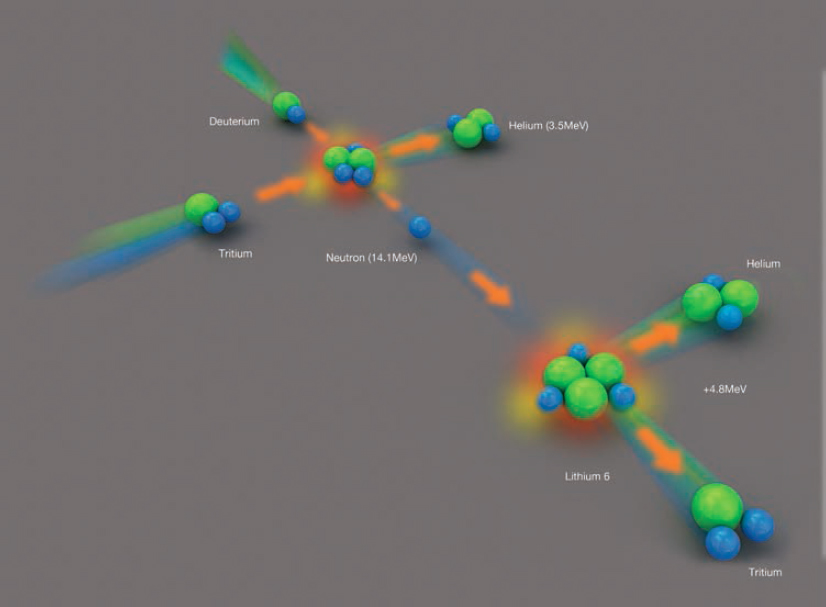
To produce net energy through fusion, the D-T particles must be confined in a region of space long enough to undergo many, many scattering interactions before finally fusing and releasing energy. The goal is then to efficiently confine a hot soup of charged particles, a plasma, with a temperature around 100 million K to enable the D-T particles to have enough energy to overcome their mutual electrostatic repulsion and produce fusion reactions. The fusion reactions can be self-sustaining if some of the energy released can be captured by the plasma and used to heat additional deuterium and tritium nuclei to fusion temperatures. Energy production above that required to sustain the fusion reactions can be utilized for other purposes including generation of electricity.
Stars, including the Sun, are powered by fusion. By virtue of its large mass, the Sun confines hot plasma very efficiently by gravitation. Most stars are powered by fusion of normal hydrogen nuclei (protons). This reaction has a very low probability (small cross-section), and a typical proton survives in the core of the Sun for billions of years before fusing. Fortunately, gravitational confinement is exceptionally
good, and the Sun has a huge number of hot protons. The excess energy of these fusion reactions creates the sunlight that enables life on earth. Unfortunately, gravitational confinement of plasmas for fusion energy production cannot be accomplished on Earth. To produce steady state fusion reactions on earth, another means of confinement must be devised.
In MFE, magnetic fields are used to confine a sufficiently hot and dense plasma so that fusion reactions can occur. Magnetic forces can limit the motion of and confine charged particles in directions perpendicular to the magnetic field. Charged particles move along magnetic field lines much like beads on a wire. (See Figure 6.2.) While a range of magnetic confinement schemes have been
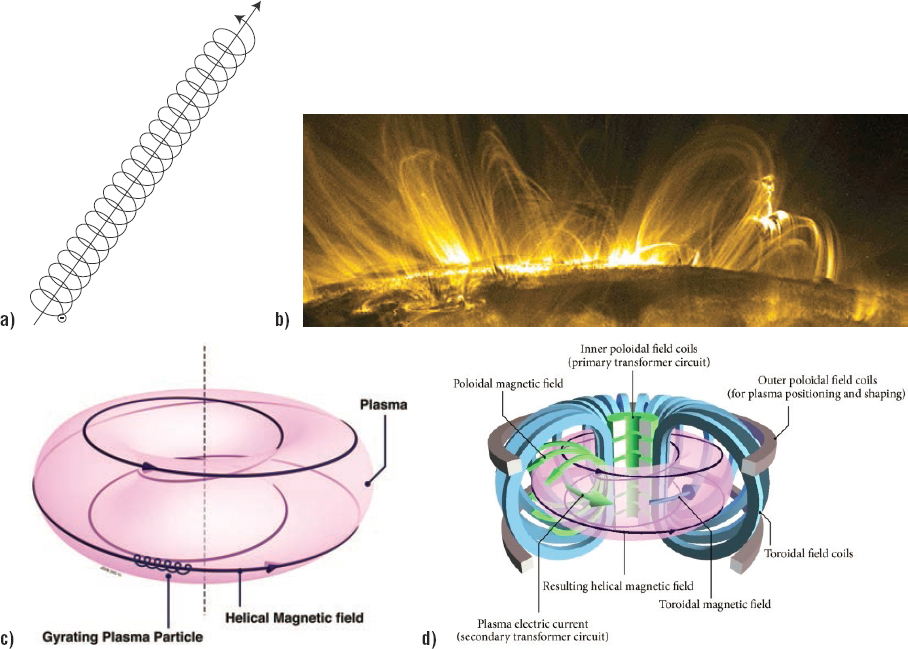
studied, the most successful so far is toroidal confinement. Using this scheme, the plasma is confined by producing magnetic field lines that wind around in a toroidal (doughnut-shaped) region. (Charged particle motion along the magnetic field is not constrained to the first order.) The simplest example of such a magnetic field is produced by a toroidal solenoid. In this case magnetic field lines are circular and close on themselves. However, due to gradients in the strength of the magnetic field, charged particles are not confined by a purely toroidal field. The particles will slowly drift out (upward or downward, depending on the sign of the charge) and be lost to the walls of the confinement chamber. The magnetic field must be made helical to achieve confinement of a charged particle. In a helical magnetic field, the charged particle is still always slowly drifting, for example, upward. However, since the particle follows the helical magnetic field line and spends some time on the underside of the torus, for part of the time drifting upward means drifting back up into the magnetic field trap. In a tokamak, the additional magnetic field (called the poloidal field) necessary to produce the helical field structure is generated by running a current through the plasma itself. In a stellarator, external magnetic coils are utilized to produce the twisted field structure, and it is not necessary to drive current in the plasma. Tokamaks have, to date, achieved the best fusion performance, including the generation of several megawatts of fusion power in the Tokamak Fusion Test Reactor (TFTR, 10 MW) at Princeton Plasma Physics Laboratory (PPPL) in the United States, and in the Joint European Torus (JET, 16 MW) at Culham Laboratory in the United Kingdom.
The international fusion community is working toward the creation of the first magnetically confined burning plasma in the laboratory. A plasma is said to be burning when energy released by fusion reactions is the dominant source of heating in the plasma. In a magnetically confined fusion plasma, the goal is to magnetically trap the energetic alpha particles produced by fusion reactions. These alpha particles then slow down and release their energy to the plasma, heating it to reach and maintain a temperature sufficient for fusion to occur. The neutrons released by the D-T reactions are not confined by the magnetic field and do not contribute to heating the plasma. Instead, the goal is to capture these neutrons in a material structure surrounding the plasma where they can be used to generate tritium from absorption by lithium atoms, and their energy can be captured for generation of electricity. ITER, based on the tokamak concept, is under construction in Cadarache, France with the goals of producing a burning plasma in the laboratory and producing more energy from fusion reactions than is required to heat the plasma to fusion temperatures. The ITER project has the goal of producing ~500 MW of power from fusion while utilizing only 50 MW of external power to heat the plasma, a fusion gain or “Q” of 10. ITER construction is more than 71 percent complete at the time of the publishing of this report, and first plasma is scheduled for 2026.
A recent National Academies study, A Strategic Plan for U.S. Burning Plasma Research1 (hereafter the “Burning Plasma report” endorsed U.S. participation in the ITER project, citing it as the best path currently available to achieving a burning plasma, a critical step in commercializing fusion energy. That study made an important second recommendation about the U.S. program beyond ITER. Recognizing that while ITER is a sound and low-risk path toward achieving the important milestone of a burning plasma and together with the knowledge gained about burning plasmas, the design is very conservative. Projections using that design extrapolate to an extremely large and costly fusion electrical power plant. Instead of only following that path, the Burning Plasma report recommended that the U.S. program also focus on investigating more economic solutions for fusion energy and pursue the development of a compact fusion pilot plant. These compact fusion concepts will use technologies that were not available at the time that ITER was designed and carry additional risk. Following the path of compact fusion reactors would uniquely position the United States in the international pursuit of fusion power, leveraging recent advances in our understanding of fusion plasmas and new developments in technology. The Burning Plasma report recommendations set the stage for a focused plasma science and engineering research program needed to enable a compact fusion pilot plant.
This proposed path forward for the U.S. MFE program is enabled by recent technological breakthroughs. In 2017, the DOE Fusion Energy Sciences Advisory Committee (FESAC) was charged “to identify the most promising transformative enabling capabilities (TEC) for the United States to pursue that could promote efficient advance toward fusion energy, building on burning plasma science and technology.” The resulting report (Transformative Enabling Capabilities for Efficient Advance Toward Fusion Energy)2 outlined a number of recent technological developments that could lead to more rapid progress or enable new promising directions in the quest for fusion energy. Highlighted were: (1) Advanced algorithms for computation and control, including machine learning and artificial intelligence; (2) new superconductor magnet technology, in particular high-temperature superconductors (HTS) using rare-earth barium copper oxide (REBCO) materials; (3) advanced manufacturing techniques including additive manufacturing; and (4) novel new technologies for production, extraction and control of tritium fuel. Magnets based on REBCO HTS in particular could enable more compact fusion reactors. REBCO conductors can carry an order of magnitude more current
___________________
1 National Academies of Sciences, Engineering, and Medicine, 2019, Final Report of the Committee on a Strategic Plan for U.S. Burning Plasma Research, The National Academies Press, Washington, DC, https://doi.org/10.17226/25331.
2 U.S. Department of Energy, 2018, Transformative Enabling Capabilities for Efficient Advance Toward Fusion Energy, https://science.osti.gov/-/media/fes/fesac/pdf/2018/TEC_Report_15Feb2018.pdf.
density than low-temperature superconductors currently in use such as niobium-tin. This higher current density allows much higher field strengths to be reached (REBCO-based solenoids have produced 40 T magnetic fields) and also allows magnets to reach the same field strength as current low temperature superconductor solutions while having smaller physical size.
MFE research has and will continue to be at the frontier of plasma science and engineering. MFE requires understanding and controlling very hot, collisionless, magnetized plasmas far from thermal equilibrium with their surroundings. This endeavor includes plasma physics that spans a tremendous range of phenomena that must be understood (and controlled) to achieve a burning plasma. Global plasma instabilities can ultimately limit the pressure and fusion power that can be generated while microinstabilities can lead to turbulence and transport of heat, limiting the efficiency of magnetic confinement. Wave-particle interactions underlie interaction of energetic particles with the plasma and schemes for heating and driving current. The interaction of hot plasmas with the material surroundings must be controlled to prevent damaging those materials. Engineering is as important as the plasma physics for fusion to be ultimately successful. Solutions are needed for confining materials that can withstand the high fluxes of heat and neutrons and maintain their integrity, for efficiently breeding tritium fuel from fusion neutrons, and for robust, capable and cost-effective magnet technologies. This report will focus on issues centered on plasma science and engineering while recognizing the importance of materials science, mechanical engineering and nuclear engineering in achieving the goal of commercial fusion power.
At the time this report3 was being written, the Department of Energy was executing a strategic planning process for MFE activities within DOE Fusion Energy Sciences (FES) to identify and prioritize the research required to advance both the scientific foundation needed to develop a fusion energy source, as well as the broader FES mission in plasma science. The process included a community-driven discussion, led by the American Physical Society Division of Plasma Physics (DPP) call the Community Planning Process (CPP). The CPP provided input to FESAC which was tasked with producing a strategic plan for fusion research for FES that will include both fusion plasma science and fusion engineering and technology. With this study and the CPP being performed at the same time, much of the data and community input from both studies was shared. At CPP workshops, consensus was found in having the output of the CPP be broadly consistent with the first two recommendations of the Burning Plasma report—continue to support ITER and to start on a path toward a compact fusion pilot plant. In particular, the CPP will utilize the second recommendation, the goal of a compact fusion pilot plant, as the basis of its strategic plan.
___________________
3 Ibid.
THE PROMISE OF MFE: CARBON-FREE, SUSTAINABLE ELECTRICITY AND THE SCIENCE AND TECHNOLOGY OF HOT PLASMAS
The societal benefit of MFE research is clear and enormous—fusion energy reactors could can provide a carbon-free source of power for generating electricity or process heat, utilizing an abundant and essentially limitless source of fuel. The fusion process that most MFE research focuses on is the D-T reaction. Tritium is radioactive with a short (13.6 year) half-life and so is not naturally available in sufficient quantities for commercial power production. However, tritium can be produced from lithium by absorption of a neutron. (See Figure 6.1.) Both deuterium and lithium are abundant in seawater (and lithium can also be mined), suggesting that there is a sufficient supply of both to use fusion power to provide the energy needs of our planet for many hundreds of thousands of years. (See Figure 6.3.) Besides providing energy and process heat, fusion reactions can be used to provide a source of neutrons for the generation of radioisotopes (e.g., for medical applications) and for transmuting waste produced by fission reactors into safer by-products.

MFE research has many links to other areas of plasma science and technology, advancing other areas of plasma science and vice versa. The collisionless, magnetized plasmas studied in fusion research exhibit phenomena that are also important in near-Earth and interplanetary space plasmas and in astrophysical plasmas. Examples of synergies include wave-particle interactions, magnetic reconnection, and turbulence driven by spatial inhomogeneities. Energetic particles are often present in fusion experiments, either generated by heating (e.g., direct injection of energetic particles by neutral beams or with radiofrequency power), as a result of fusion reactions (helium nuclei, called alpha particles, from D-T fusion) or by disruption of the plasma current in a tokamak (producing runaway electrons). These energetic particles can excite waves that in turn scatter, deenergize and eject particles from the magnetic trap. The same processes occur in Earth’s radiation belts and magnetosphere, where energetic protons and relativistic electrons are trapped and similar types of waves (Alfvén and whistler) can both energize and scatter these particles. Magnetic reconnection (where magnetic field lines are broken and, reconnect, producing large releases of energy—see Chapter 2) is ubiquitous in space and astrophysical plasmas, leading to stellar flares and perhaps gamma ray bursts (see Chapter 7). This same process occurs in fusion plasmas in fast nonlinear tearing modes that limit their performance. Turbulence in fusion plasmas is often driven by strong spatial inhomogeneities in plasma current or pressure, as is turbulence in Earth’s ionosphere and planetary magnetospheres. Interactions between the fusion, space and astrophysical, and basic plasma communities have steadily grown in ways that have benefited all participants. For example, the gyrokinetic computer codes created to understand and predict turbulence and transport in fusion plasmas are used to investigate turbulence in the solar wind and in stellar accretion disks, contributing to our understanding of how electron and ion heating works in these settings.
There are also links of fusion to the low temperature plasma community. All fusion plasmas ultimately involve interactions with material surfaces. These plasma material interactions (PMI) can erode plasma facing components and introduce impurities into the core fusion plasma, potentially degrading confinement by processes including radiation. Similar plasma material interactions occur in plasma processing equipment used to create semiconductors and in plasma-based thrusters.
PROGRESS IN MFE RESEARCH SINCE PLASMA 2010
Since the Plasma 2010 report4 was published, significant progress has been made on the underlying science of magnetically confined plasmas for fusion energy research. A number of highlights are provided below.
___________________
4 National Research Council, 2007, Plasma Science: Advancing Knowledge in the National Interest, The National Academies Press, Washington, DC, https://doi.org/10.17226/11960.
Understanding and Controlling the H-Mode Edge
The advances in MFE science in heating and confinement achieved using tokamaks is in large part linked to the discovery of the high-confinement mode or “H-Mode.” This operational mode can be accessed by exceeding an empirical threshold in heating power and leads to an edge transport barrier where strongly sheared radial electric fields suppress turbulent transport. This edge transport barrier is known as the “pedestal,” which has a very large gradient in plasma pressure, much larger than the pressure gradient in the core region of the plasma inside the pedestal. The pedestal’s formation, height, and stability are therefore key drivers of overall fusion performance, since fusion power scales with the square of the plasma pressure. Numerous mechanisms, including collisional “neoclassical” transport and electron scale turbulence, can drive heat and particle transport across the pedestal. However, due to very strong sheared plasma flow, electromagnetic effects, and the presence of large heat and particle sources, the pedestal is often limited by electromagnetic instabilities driven by pressure and current gradients. These instability producing processes are known as kinetic ballooning modes (KBM) and peeling-ballooning (P-B) modes. (See Figure 6.4.) A simple model, EPED, has had significant success in predicting the pedestal pressure and width, the outcomes of which are particularly important to both KBM and P-B. (See Figure 6.5.) The model predicts that when the plasma has a highly triangular plasma shape and a
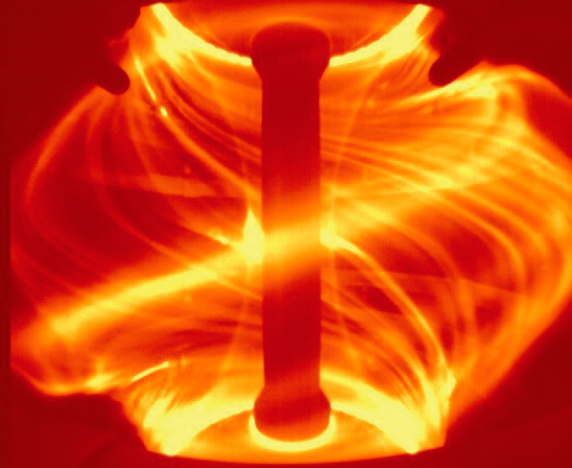
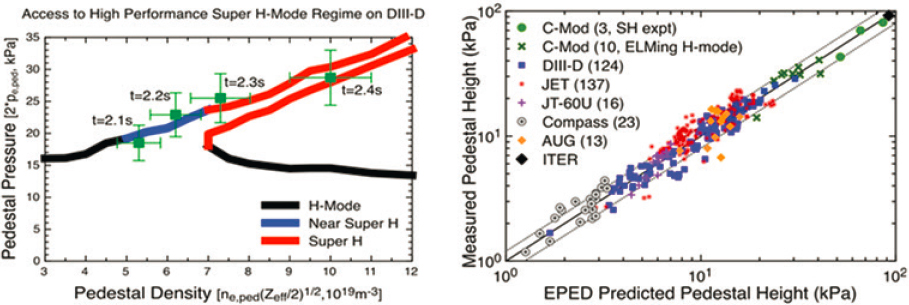
particular range of densities, the pedestal can bifurcate into the usual “H-Mode” and a higher pressure “Super H-Mode.”
Motivated by theoretical predictions, recent experiments have explored the Super H-Mode regime. A record pedestal pressure of 80 kPa was obtained in the Alcator C-Mod Tokamak at the Massachusetts Institute of Technology. A record fusion gain for a medium scale (major radius R < 2 m) tokamak was obtained in pure deuterium experiments on the DIII-D National Fusion Facility tokamak at General Atomics. Deuterium-deuterium fusion reactions have a lower cross-section than D-T reactions. If D-T had been used in these experiments a fusion gain (ratio of fusion power produced to heating power input) of ~0.5 would have resulted.
Operation in H-mode produces significant increases in confinement time and performance over L-mode (or “low-confinement” mode, without an edge transport barrier). It is expected that ITER will access H-mode to achieve the goal of producing a burning plasma. There is a risk, however, since the H-mode pedestal can suffer instabilities that leads to edge localized modes (ELMs). These instabilities cause a fraction of the core plasma pressure to be abruptly lost, producing significant heat and particle loads on the plasma-material interface, especially at the divertor plates where the plasma is exhausted from the system. (See Figure 6.3.) Although ELM-induced particle transport has a beneficial effect in allowing density and impurity control within the core plasma, the pulsed heat load can cause rapid erosion of these divertor plates. This instability is a major risk to the ITER device
and its operation. Either ELM mitigation or, preferably, operation without ELMs, is necessary while still maintaining H-mode levels of energy confinement combined with adequate particle transport for helium ash removal and impurity control.
A significant breakthrough over the last 10 years is the use of small, nonaxisymmetric, three-dimensional (3D) magnetic fields called Resonant Magnetic Perturbations (RMP) to mitigate or eliminate ELMs. Experiments on the DIII-D tokamak5 were the first to demonstrate that ELMs can be completely eliminated through application of RMP while maintaining high-performance H-mode transport barriers. Based on the initial success of 3D magnetic field control research in DIII-D, many of the major international tokamaks, including MAST, ASDEX-U, KSTAR, EAST, HL-2A, J-TEXT and COMPASS have installed similar capabilities, and have contributed to our physics understanding of the interaction of these small nonaxisymmetric magnetic fields with the nominally axisymmetric tokamak magnetic equilibrium. Improved theoretical and computational capabilities have accompanied experimental progress using a variety of MHD (magnetohydrodynamic) codes (e.g., M3D-C1, NIMROD, MARS, JOREK, VMEC, TM-1, IPEC/GPEC). These codes have been generalized to include the plasma response to imposed nonaxisymmetric magnetic fields. They have been able to explain many, but not yet all, of the experimental observations. For example, explanations of observed multimode responses, ELM-suppression bifurcations, rotation thresholds for suppression and density pump-out, have given increased confidence in use of such techniques on ITER. (Density pump-out is a local reduction in plasma density due to increased transport associated with the imposed RMP.) Nevertheless, a number of phenomena are still not yet fully understood, including the exact mechanism of ELM suppression and the robustness of the temperature pedestal despite density pump-out. Based on the success of RMP ELM suppression, a set of 3D magnetic field coils has been incorporated into the ITER design. (See Figure 6.6.)
While progress in ELM mitigation has been impressive, the effectiveness of these mitigation strategies is often limited to particular operational regimes. Identifying a general path to ELM-free, high performance operation is a major goal. Over the last 10 years, two possible operational regimes have been identified and their operational space expanded, these being the intermediate-mode or “I-mode” and the quiescent-H-Mode or “QH-Mode.”
The I-mode is a stationary operating regime with improved thermal confinement but unaltered (and favorable) particle confinement which occurs at input powers below those required for the L- to H-mode transition. The I-mode has the following characteristics: (1) formation of ion and electron temperature pedestals, (2) increase in stored energy relative to L-mode, (3) little or no change in density
___________________
5 A table of fusion facilities appears later in the chapter, providing more information on the devices cited here.
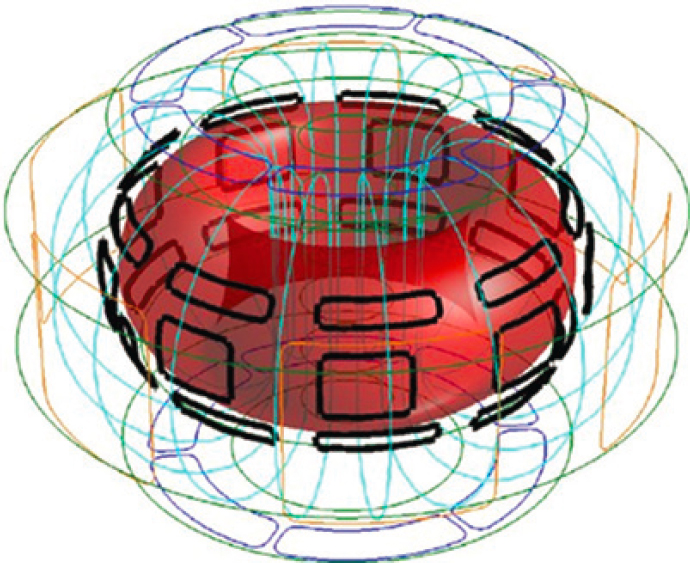
relative to L-mode, (4) flow shear in the edge pedestal region which is intermediate between that found in L-mode and H-mode, (5) usually no ELMs, and (6) changes in the edge turbulence with decreases in some frequency ranges and increases in others. Operation with increased energy confinement but unchanged particle confinement is particularly relevant for future reactors, since fusion power would be enhanced while impurity and ash removal would be facilitated. (Ash refers to the fusion alpha-particles that have given up their energy to the plasma and must be removed from the plasma.) What is now recognized as the I-mode was first seen in Alcator C-MOD and ASDEX-U in the late 1990s but its significance was not apparent at that time and work on this regime was dormant for about 10 years. I-mode experiments resumed in C-MOD prior to its decommissioning and the significance of I-mode as a stationary regime was recognized. Since the mid-2000s, considerable work on the I-mode has been done on Alcator C-MOD, ASDEX-U, and DIII-D and EAST.
The QH-mode, a stationary H-mode without ELMs, was first discovered in DIII-D and was subsequently investigated on ASDEX-U, JET and JT60-U.
The initial discovery resulted from operating in lower density plasmas and forcing the plasma to rotate in a direction opposite to the direction of the plasma current. This was accomplished by driving plasma rotation using neutral beam injection (called counter-NBI). Experiments over the last 10 years have broadened the range of QH-mode operation to include plasma rotation in the current direction (co-NBI) and to operate with balanced (no torque) NBI but using magnetic perturbations from external coils to drive flows. This result makes QH-mode operation on ITER possible as NBI torque will be limited due to the large size of the ITER plasma and limited penetration of neutral beams. The key to standard QH-mode operation is the excitation of the edge harmonic oscillation (EHO), which is a coherent edge electromagnetic mode. The EHO provides extra edge transport and prevents the edge pressure gradient from reaching the stability boundary for ELMs.
The standard QH-mode operates at edge conditions, matching those in future devices such as ITER. However, to achieve the predictive understanding needed for use in future fusion reactors, we need a detailed, validated theory of the EHO. Although results from linear stability analysis have provided a significant understanding of the mode, we need a complete theory of the saturated, nonlinear state and how the EHO drives cross magnetic field transport. Some promising initial modeling of the EHO has been performed but much remains to be done.
Multiscale Processes in MFE Plasmas
Processes in magnetized plasmas span a huge range of spatial and temporal scales. For example, the timescales in a tokamak plasma range from rapid Langmuir plasma oscillations, ~0.1 ns, to slow global current diffusion, ~10 s. The Plasma 2010 report6 recognized the importance of and scientific opportunity to study “multiscale” processes in magnetized plasmas. These include dynamics with strong coupling between, for example, large and small spatial scales. Gaining insight into such processes is demanding. Substantial resources in massively parallel simulations are required to simultaneously resolve both the small and large spatial or temporal scales. Important progress in this regard has been made over the last 10 years. Two examples are in the multiscale interaction between ion and electron scale turbulence and in the interaction between global MHD instabilities and microturbulence.
Decades of experimental and theoretical plasma physics research has shown that turbulence is driven by unstable gradients in plasma properties (electron density and temperature, ne, Te; and ion temperature Ti). This turbulence is likely to be responsible for the “‘anomalous’” transport observed in the core of many fusion devices. (Anomalous transport refers to movement of plasma that proceeds faster
___________________
6 National Research Council, 2007, Plasma Science: Advancing Knowledge in the National Interest, The National Academies Press, Washington, DC, https://doi.org/10.17226/11960.
than classical, linear scaling laws would predict.) Long wavelength turbulence, present at the ion-scale, is defined as turbulence with a poloidal wavenumber less than the ion Larmor radius (kθρi < 1.0). (The poloidal wavenumber, kθ, is the inverse of the typical scale size of the turbulent structures.) At this scale the ion temperature gradient (ITG) and trapped electron mode (TEM) turbulence are thought to be important in explaining experimentally observed transport. The analog of ITG turbulence is known to exist at the shorter electron scale. Electron temperature gradient (ETG) turbulence is found at short wavelengths, with poloidal wavenumbers less than the electron Larmor radius (kθρe < 1.0). Historically, the role of ETG turbulence has generally been thought to be limited due to their presumed small eddy size. However, early numerical simulations indicated that ETG turbulence could form radially elongated “streamers” that increase the transport associated with ETG and could lead to experimentally relevant heat flux levels in conditions without long wavelength turbulence. Despite this finding, it was believed that in the presence of long wavelength turbulence, streamers would likely be sheared apart by the long wavelength turbulence leading to a reduced impact of the ETG.
The evolution of modern supercomputing platforms has enabled a new type of gyrokinetic simulation that is able to capture the spatial and temporal scales of ion and electron-scale turbulence simultaneously. (See Figure 6.7.) (Gyrokinetic models
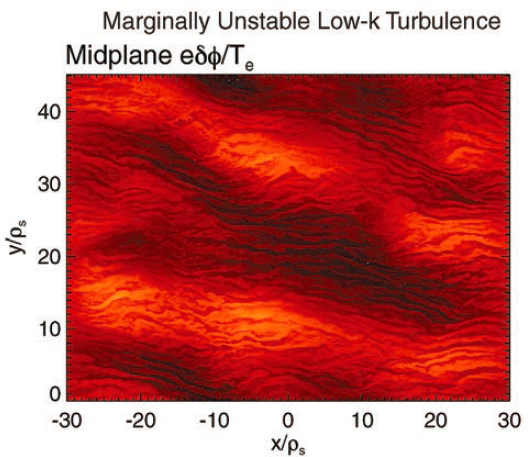
average over the rapid charged particle motion in orbits around the magnetic field to focus on slower, lower frequency processes including slow particle drifts and low-frequency turbulence.) Early attempts at these multiscale simulations used artificially heavy electrons to slow their motion to better match that of the ions, and simplified plasma geometry and profiles to reduce the range of scales and lessen the computational demands. As a result, these studies generally concluded that electron temperature gradients (ETG) would likely play a minor role in heat transport. However, comparisons of model results showed notable disagreements with experimentally measured levels of electron heat flux. The origin of these disagreements was not clear.
Steady advances in computing have enabled the first multiscale simulation of experiments to be performed with actual electron mass and all experimental inputs. Motivated by the disagreement in electron heat flux between ion-scale gyrokinetic simulation and experiment, realistic multiscale simulations in the core of the Alcator C-Mod tokamak were performed. These simulations pushed the limits of supercomputing, requiring ~20 million CPU hours per case. Their outcomes showed that ITG turbulence could, in fact, coexist with ETG streamers. Complicated cross-scale interactions were observed in these simulations. Through modification of the zonal flows and cross-scale energy transfer it was found that short wavelength turbulence actually increased the heat flux driven at long wavelengths. An extensive validation of multiscale simulations with comparisons to experiments demonstrated that only multiscale simulations capable of capturing cross-scale interactions could reproduce the observed heat fluxes found in experiment. These efforts produced a likely explanation for the origin of electron heat flux in the core of tokamaks. Further simulation studies showed that cross-scale coupling is likely important in the core of high performance conditions, like those projected for the operation of ITER and future fusion devices. The importance of multiscale turbulence remains an active area of investigation with important implications for the model fidelity needed for prediction and interpretation of fusion devices.
Progress has also been made in understanding the multiscale interaction between global modes and microturbulence in confinement devices. Neoclassical Tearing Modes (NTMs) are a major impediment to the development of operational scenarios for tokamaks as they can limit plasma pressure and can lead to plasma termination—called a disruption. NTMs produce magnetic islands that lead to flattening of the pressure profile within the island. (See Figure 6.8.) This is caused by rapid transport (parallel to the magnetic field) within the island. In toroidal plasmas with large enough pressure a self-generated “‘bootstrap”’ current arises that is proportional to the gradient of the pressure associated with trapped particles. (Bootstrap current is a toroidal current produced in the presence of a pressure gradient.) The pressure flattening in an NTM acts to reduce the pressure gradient at the island and hence removes bootstrap current from that region.
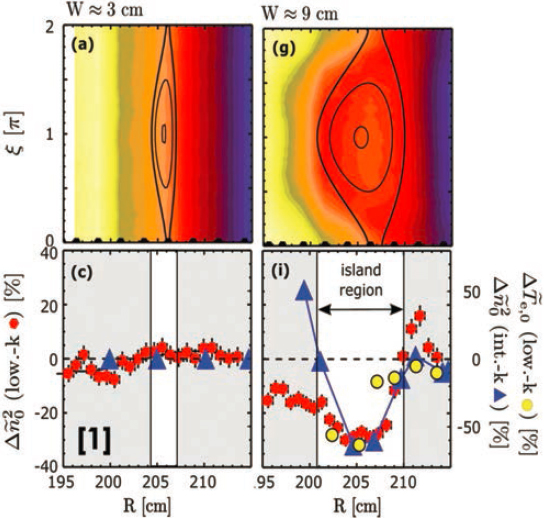
This reinforces the island and causes it to grow in size. Turbulent transport around the island can prevent or reduce this pressure flattening and affect the dynamics of the NTM island. At the same time, pressure flattening by the NTM also removes the source of turbulence, leading to a complex nonlinear and multiscale interaction between microturbulence and the NTM. The first direct measurements of this interaction were made on the DIII-D tokamak.
In the reversed field pinch (RFP) unstable global tearing modes drive a cascade spanning multiple scales which has been compared to the magnetic turbulence spectrum of the interstellar medium. Measurements show that the cascade acquires features at small scale associated with disparate microscale physics. Gyrokinetic simulations demonstrate that the global and microscales couple through zonal flows. (Zonal flow refers to plasma flowing within a magnetic surface primarily in the poloidal direction.) These regulate small-scale turbulence while being regulated themselves by large-scale magnetic fluctuations. The role played by zonal flows makes this phenomenon potentially relevant to the most important types of instabilities in magnetic confinement fusion. Recent experimental measurements and
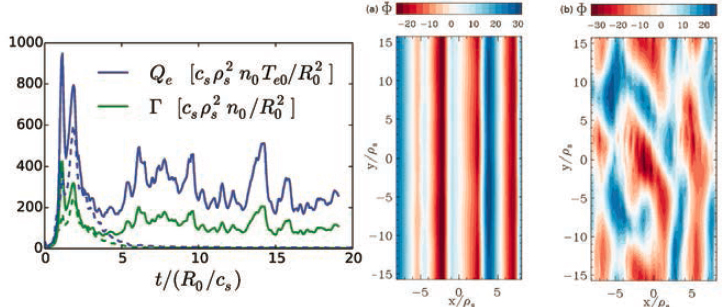
modeling show that this physics also arises in DIII-D tokamak plasmas, where resonant magnetic perturbations (RMPs) raise fluctuation levels and reduce zonal flows. This has been tested in DIII-D using an RMP whose magnitude is varied to test the response of turbulent fluctuations. The frequency spectrum of density fluctuations from beam emission spectroscopy for four different values of the RMP coil current is shown in Figure 6.9. Increasing coil current uniformly increases the fluctuation level over the frequency range of microturbulent fluctuations (40-120 kHz).
Energetic Particle Driven Modes
Energetic particles (EP) such as the 3.5 MeV alpha particles generated by D-T fusion reactions, fast beam ions from neutral beam injection and high energy tail ions generated by radio frequency (RF) heating play critical roles in heating, current drive, and momentum input. The confinement of these EP is essential in future fusion reactors. Confinement of these particles, however, faces several challenges. The most significant is that these particles can excite a variety of instabilities, which in turn lead to EP transport or loss. This interplay between EPs and instabilities is a fundamental wave-particle interaction problem that spans all areas
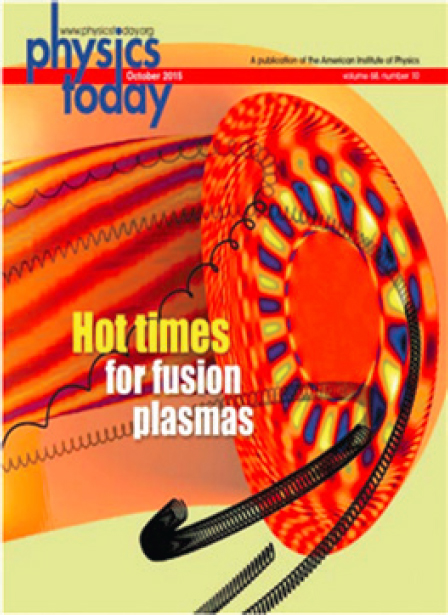
of plasma physics from the interstellar medium to tokamaks. Since the Plasma 2010 report, research on EP interactions with instabilities has progressed rapidly due in large part to advances in diagnostics for both fast ions and the instabilities themselves (see Figure 6.10). For example, measurements of the confined fast ion profile are available (using Fast Ion D-Alpha (FIDA) spectroscopy) and structures are routinely measured using electron cyclotron emission. A decade ago, measurements of ion transport in the presence of Alfvén eigenmodes (a type of EP driven instability) was an unresolved issue. Research in the last decade has resolved this issue and revealed the key underlying physics of the measured fast ion transport. This effort utilized detailed experimental data coupled with theory and simulation. This was accomplished first by tracking energetic particle orbits through magnetic perturbations consistent with measurements and second by using massively parallel computation to self-consistently evaluate the interaction between energetic particles and MHD modes. The primary factor causing the transport was found to be the overlap of many wave-particle resonances. Comprehensive simulations are now able to identify not only the basic properties of EP driven but the feedback that impacts the EP profile.
Optimized Stellarators and Wendelstein 7-X
As discussed earlier, plasmas cannot be confined with purely toroidal (circular) magnetic fields due to drifts caused by gradients in the magnetic field. Instead the magnetic field must have some “rotational transform,” meaning the magnetic field line must be helical rather than circular. In tokamaks, external current coils produce a purely toroidal field. In a stellarator, the helical magnetic field is produced entirely by specially designed external coils, and no plasma current is required. (See Figure 6.11.) To generate the helical field, the coils cannot be axisymmetric and the resulting magnetic field pattern is three-dimensional and not rotationally symmetric as in a tokamak. In the past decade, a significant advance in 3D plasma confinement has been the Wendelstein 7-X (W7-X) stellarator at the Max Planck Institute for Plasma Physics in Greifswald which began plasma operations in 2015. W7-X, the largest stellarator in the world, is an optimized stellarator, designed with a magnetic geometry intended to reduce neoclassical transport (losses of heat and particles due to collisions between particles that are in a special class of orbits called trapped orbits). W7-X, achieved the record fusion triple product (nTτ—density × temperature × confinement time) for stellarators.
The United States supplied a “trim” coil system for WX-7 that was utilized in conjunction with the flux surface measurement diagnostics to confirm the accuracy with which the 70 superconducting magnetic field coils were placed, an accuracy necessary to produce the complex array of magnetic fields. (See Figure 6.12.) Initial operation also enabled the very first assessment of neoclassical transport behavior including bootstrap current. In a tokamak, bootstrap currents are beneficial as they reduce the amount of plasma current that must be driven by external means. However, in a stellarator, bootstrap currents can potentially modify the magnetic field structure being imposed externally which can lead to degraded performance. Hence, in stellerators, one seeks to minimize bootstrap currents. W7-X experiments further validated theories for the radial electric field and bootstrap current
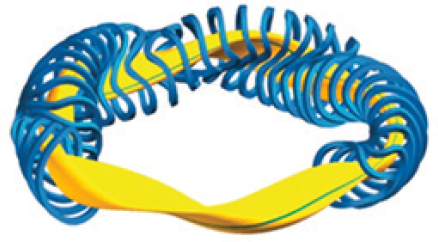
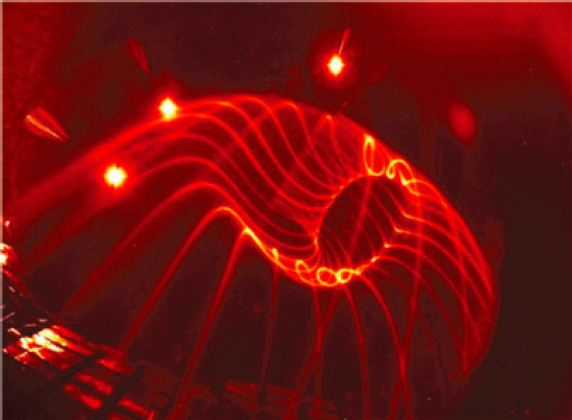
in stellarators, showing that the device’s optimization for minimal plasma current was successful. Operation of WX-7 with pulse lengths in excess of 30 s (much longer than the “energy confinement time” defined as the stored thermal energy in the plasma divided by the heating power) confirmed neoclassical bootstrap currents in line with optimization criterion.
Toroidal confinement devices utilize a magnetic geometry that directs heat and particles exhausted from the core plasma to a material surface designed to handle this power exhaust. This magnetic geometry and material surface is called a divertor. Installation of uncooled divertor elements during a second commissioning campaign in W7-X enabled experiments demonstrating the island diverter concept (a special magnetic geometry for a stellarator divertor), assessing diverter protection elements, and achieving current pulse lengths of up to 100 s. A set of U.S. supplied diverter overload protection elements (“scraper elements”) were installed and successfully assessed. Edge spectroscopic measurements enabled assessment of impurities in W7-X and the ability of the island divertor to prevent impurities from the edge region from propagating into the core plasma. A desirable mode of divertor operation, demonstrated on W7-X, is called a “detached” divertor, where power exhausted from the core plasma is absorbed and reradiated by a buffer gas before hitting material surfaces. In addition, operation of electron cyclotron resonance heating (ECRH) and frozen hydrogen pellet injection for fueling led to high performance discharges. Experiments using edge gas puffing confirmed that not
only was diverted operation possible in steady-state scenarios, but that it resulted in no significant impact on confinement or impurity screening.
At the time of this report, W7-X is finishing installation of water cooled in-vessel components that will enable it to run for 1800 s with 10 MW of injected ECRH power. In 2021, the device will resume operation with a fully cooled divertor which has been qualified for up to 10 MW/m2 steady-state operation (20 MW/m2 transient). The completed device will enable scientists to address plasma physics related to energetic particles, turbulence, plasma stability, magnetic island physics, and plasma material interactions. A 7 MW neutral beam system and 1 MW ion cyclotron resonance heating system will enable investigations of energetic particles in three dimensional magnetic fields. Fluctuation diagnostics will be used to investigate how both magnetic fields and plasma gradients influence turbulence. Stability limits and the physics of magnetic islands can be studied through the device’s flexible magnetic configurations. For the first time, scientists will have access to heat fluxes up to 10 MW/m2 for up to 1,800 s, facilitating world leading plasma material science.
Alternative Magnetic Configurations
While the tokamak and stellarator magnetic configurations have demonstrated performance closest to those needed for a fusion reactor, these concepts have appreciable engineering complexity. Tokamaks require plasma current to be sustained, and stellarators, while inherently steady state, require complex nonplanar magnetic coils. Other magnetic configurations, often called “alternative concepts,” offer the potential for significant reduction in engineering complexity while also being challenged in confinement and stability. The main alternative concepts include:
- Open magnetic field topologies, for example, the centrifugally confined mirror, the gas dynamic trap (axisymmetric mirror), and the flow-stabilized Z-pinch;
- Closed magnetic fields topologies. Those concepts having a moderate toroidal field include the reversed field pinch and spheromak. Those with no toroidal field include field reversed configuration and levitated dipole;
- Pulsed concepts that rely on magnetic insulation or imploding liners such as magneto-inertial fusion (a.k.a. magnetized target fusion).
Key potential advantages for non-tokamak, non-stellarator configurations are listed in Table 6.1. There has been progress in developing each of these configurations, but DOE-FES support for alternative concepts has been greatly curtailed in the last decade.
Much of the recent progress on alternative concepts has been supported by private industry and DOE ARPA-E. As one example, the Z pinch provides a simple magnetic confinement configuration for plasma and has many advantages as a
TABLE 6.1 Advantages of Non-Tokamak, Non-Stellarator Magnetic Fusion Configurations
| Configuration | Near-Unity Beta | Increased Compactness | Reduced Field at Magnet | No Auxiliary Heating | Simply Connected Geometry | Advanced Fusion Fuels | Steady State (S) or Pulsed (P) |
|---|---|---|---|---|---|---|---|
| Gas Dynamic Trap | ♦ | ♦ | S | ||||
| Centrifugal Mirror | ♦ | ♦ | S | ||||
| Reversed Field Pinch | ♦ | ♦ | ♦ | S | |||
| Spheromak | ♦ | ♦ | ♦ | ♦ | S | ||
| Field-Reversed Configuration | ♦ | ♦ | ♦ | ♦ | ♦ | S | |
| Levitated Dipole | ♦ | ♦ | ♦ | S | |||
| Flow Z-pinch | ♦ | ♦ | ♦ | ♦ | ♦ | ♦ | P |
| Magneto-Inertial Fusion | ♦ | ♦ | ♦ | ♦ | ♦ | ♦ | P |
NOTE: The last column identifies inherently pulsed (P) or a steady-state sustainment scenario that is identified (S).
compact fusion reactor, such as an order unity plasma beta and no magnetic field coils. (The plasma beta is the ratio of plasma pressure to magnetic pressure.) Equilibrium in Z-pinches is ideally produced by the radial force resulting from the azimuthal magnetic field that is generated by the directly driven axial current. MHD plasma instabilities, well known theoretically and experimentally, have largely precluded achieving long-lived high-performance Z-pinch plasmas. Sheared axial flows, where flows along the magnetic field are different at different radii, were theorized to stabilize these troublesome MHD modes. Unlike the addition of axial magnetic fields, equilibrium axial flows do not alter the radial force balance, thereby preserving the Z-pinch scaling relations. Separating the plasma properties that determine stability from those that specify the equilibrium makes the shear flow stabilized (SFS) Z-pinch appealing as a thermonuclear fusion device and as a research platform for high performance plasmas.
Experimental measurements coupled with numerical simulations confirmed a correlation between flow shear and plasma stability. These shear flows produced stable plasmas with ion temperatures over 1 keV in a 0.3 cm radius 50 cm long Z-pinch. A collaboration between the University of Washington and Lawrence Livermore National Laboratory has been exploring the possibility of using the SFS Z-pinch as a compact fusion device. With a more robust experimental configuration and improved pulsed power and gas injection, the SFS Z-pinch, FuZE (Fusion Z-pinch Experiment), has demonstrated sustained steady fusion from a quiescent plasma when the pinch current is high. Experimental data are presented in Figure 6.13 that demonstrate sustained fusion neutron production when a H2-D2
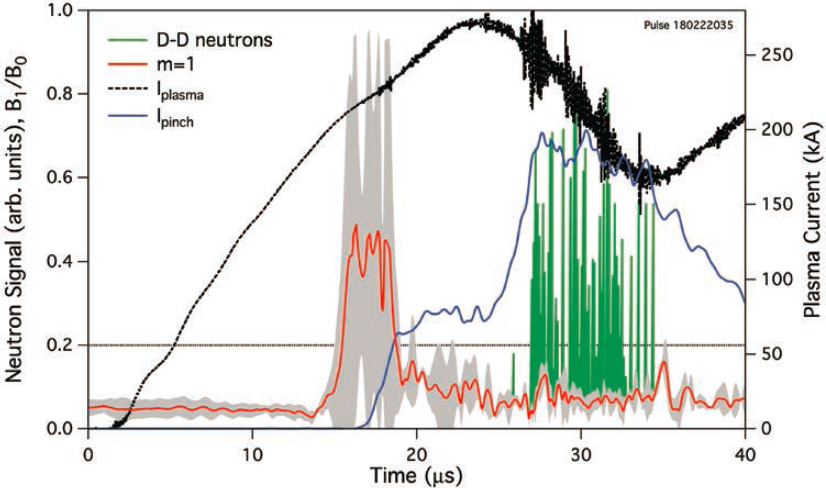
mixture was used in the FuZE device. Neutrons are observed to be produced at a constant rate when magnetic fluctuations are low and pinch current is high.
Scintillator detectors used to image the neutron emission volume on FuZe show that the neutrons emitted uniformly along a 34 cm long section of the 50 cm Z-pinch can be attributed to a thermonuclear process. Numerical fluid and kinetic simulations have been tightly coupled with the experimental investigation and have been instrumental in developing physical insight into the SFS Z-pinch operation. High-fidelity kinetic simulations demonstrate the effectiveness of sheared flow stabilization and find a flow shear required for stability that is approximately equal to the value from linear theory.
Progress Toward a Burning Plasma: ITER
Successful fusion concepts require a core plasma that is “burning”—that is, the absorption of energy released by fusion reactions is the dominant source of heating within the plasma. In particular, this heating is dominated by energetic alpha particles born in fusion reactions. These energetic particles slow down by collisions with bulk electrons and ions, and in the process transfer energy to them, resulting
in plasma heating. However, a significant population of energetic alpha particles can lead to instabilities—plasma waves can be resonantly excited through interaction with the alpha particles. In turn, these plasma waves can cause scattering and loss of the alpha particles from the magnetic trap and can also cause unwanted transport and loss of the bulk D-T plasma. In current tokamak experiments, plasma heating can be controlled and localized in space in order to achieve desired plasma profiles and improve plasma performance. In a burning plasma, there is a strong feedback mechanism between the plasma profiles and fusion heating—more fusion will occur in the hottest and densest region of the plasma, which provides positive feedback by providing more heating locally. The burning plasma can therefore “self-organize” and the ability to use external heating to control plasma profiles is diminished. Studying this self-organized state with dominant alpha-particle heating is critically important to successfully designing and operating a fusion power plant. The study of burning plasmas was raised as a key scientific challenge for MFE research in Plasma 2010 and will continue to be a focus of the field for the next decade.
To perform critical studies of a burning plasma in the laboratory, the United States has been a partner in the international ITER project since 2003. ITER is being built in Cadarache, France, by a collaboration of 35 nations. The United States is a 9 percent partner in the ITER construction project. The ITER project is one of the most complicated and largest scientific experiments ever constructed. The project has unfortunately suffered from significant delays over the last decade. The original plan for first plasma was 2018 but that has now slipped to 2026. In part because of these delays, some concerns were raised by Congress and DOE leadership over whether remaining a partner in ITER is the right strategy for the U.S. program. As a result, the Burning Plasma Committee of the National Academies of Sciences, Engineering, and Medicine was charged to evaluate U.S. participation in ITER in 2015. Around the same time, a change in management occurred within the ITER Organization with Dr. Bernard Bigot taking over as director. Dr. Bigot’s new management produced a more realistic timeline and costing for the project; and has kept to the project cost and schedule. At the time of publishing this report (end of 2020), the ITER construction project is 71 percent complete. (See Figure 6.14.)
SCIENTIFIC OPPORTUNITIES FOR MFE RESEARCH
Future science challenges and opportunities in MFE are being strongly driven by the Burning Plasma Committee study recommendations. The first recommendation from that report, that the United States remain a partner in the ITER project, represents the lowest risk route to studying the physics of a burning plasma. The Burning Plasma Committee released an interim report which states: “burning plasma research is essential to the development of magnetic fusion energy and contributes to advancements in plasma science, materials science, and the nation’s
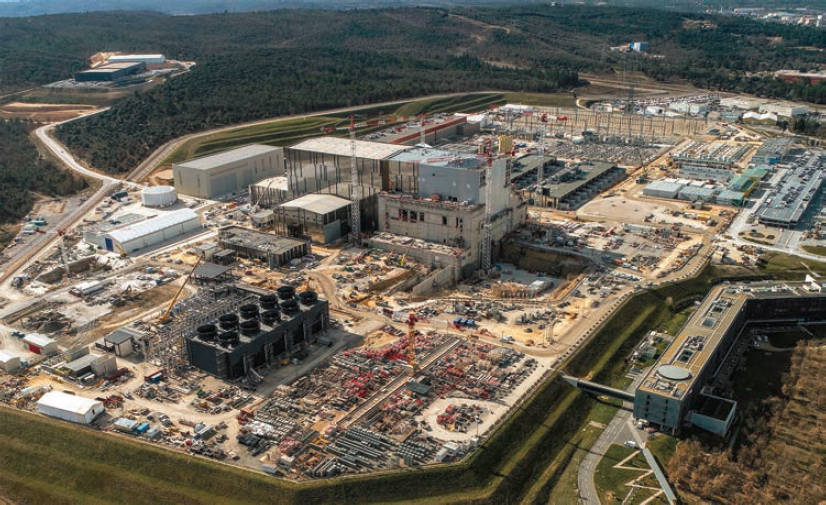
industrial capacity to deliver high-technology components.” Further, the report states that “any strategy to develop magnetic fusion energy requires study of a burning plasma.” Active participation in the ITER project is necessary for the United States to derive full benefit from the ITER project in its quest for a domestic fusion power plant. Effective participation in ITER requires that the United States continue to invest in domestic tokamak facilities and research to address operational issues for ITER and prepare the physics and fusion technology needed to enable next step devices. Such an active domestic experimental program would ensure that the United States gains maximum benefit from a successful ITER project along with a strong research and development program that:
- Provides solutions and technical support for successful preparation and operation of the ITER facility. In some areas the United States is world-leading and is providing contributions essential to ITER.
- Prepares and provides a team of talented and experienced researchers to participate in the ITER program and bring its results back to the domestic program.
- Develops the physics basis and tools to take ITER’s results and make use of them to take the next steps on the path to developing cost-effective fusion reactors.
By supporting strong U.S. participation in ITER, including continued strength in these three areas, the United States will be positioned to build on ITER’s accomplishments to move toward the ultimate goal of fusion powered electricity generation.
The second recommendation of the Burning Plasma Report is that the U.S. program pursue science and engineering activities leading to the development of a compact fusion pilot plant, representing a more economical approach to fusion power. More compact reactors require improved performance of the core plasma, likely enabled by the increased magnetic field, but also exacerbate the challenge of handling the power exhaust from the device by shrinking the surface area over which heat can be exhausted. Tokamaks must show a route toward high performance, sustained discharges with a solution for maintaining the plasma current required for confinement. In addition, unplanned plasma terminations or disruptions and ELMs must be avoided or mitigated to prevent damage to the plasma facing components and structural components.
Stellarators provide an attractive alternative route to a fusion pilot plant that does not need plasma current sustainment, so the recirculating power fraction can be reduced and reactor economics improved absent the requirement for current drive. They are also inherently steady state and do not suffer from current disruptions. Stellarator research must address core thermal and energetic particle confinement, which are deficiencies relative to the tokamak, and identify a divertor solution for power handling. Reactor concepts based on alternative concepts could also reduce cost and complexity by mitigating other fundamental challenges, like auxiliary heating. Collaboration between private industry, DOE ARPA-E, and DOE-FES offers the most expedient path forward for the development of these alternatives. Developing validated predictive capability for core plasma behavior and for plasma material interactions remains an essential challenge to achieving fusion energy. Multiconfiguration research (exploring alternatives to the tokamak and stellarator) has been and can continue to be part of the strategy to test fundamental plasma models and inject innovation.
Taming the Plasma Edge: Solving the Power Exhaust Problem
The MFE research program must establish the scientific and technological basis for ensuring adequate power handling in a compact fusion pilot plant (CFPP). The region surrounding the core plasma from which heat flows to the divertor is called the scrape-off layer or SOL. Designing a power exhaust solution (divertor geometry and materials) for a fusion reactor requires confident projections of the expected heat flux in the SOL and the conditions that will result in its mitigation to stay below material limits. Recent empirical and model-based projections of the heat flux in next-step devices indicate a very strong scaling with the magnet field.
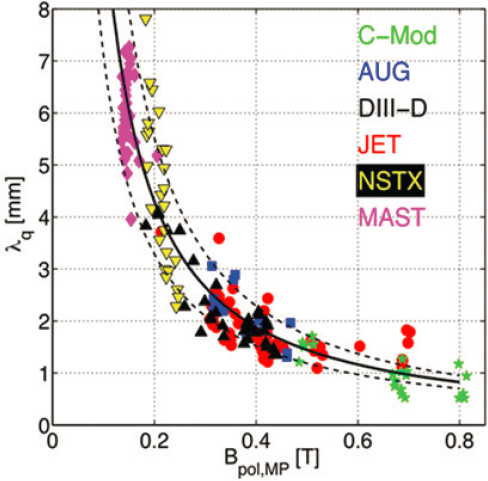
(See Figure 6.15.) For tokamak concepts that rely on increasing the magnetic field, this scaling implies extremely large fluxes that could exceed material limits. This heat flux can be mitigated by injecting higher mass impurities into the divertor region, with the goal of absorbing and reradiating the exhausted power (which will be spread over a much larger surface area). This scheme can lead to a so-called “detached” divertor, where the majority of the heat flux is radiated away before reaching the material surface. Investigations of the impurity fraction required for radiative flux to disperse the exhaust heat in high-field devices suggest that the impurity fractions are manageable for next-step devices. These scalings require validation and more comprehensive models. Current projections and models rely on assumptions for impurity transport that require more theoretical and experimental corroboration. Confirmation of the predictions for the impurity requirements are essential. There is an upper limit to the impurity content that can be tolerated in tokamaks related to the ability to screen these impurities from the core plasma and induce further compression in the boundary plasma.
Solutions for the power exhaust problem should not sacrifice high-performance in the core plasma. The high neutral density needed to enhance radiation in the divertor region and reduce heat fluxes to material surfaces can have a negative
impact in the region of the H-mode pedestal and core plasma. Research is needed to explore how the divertor geometry can be optimized, leveraging advanced magnetic configurations or physical design, to limit the negative impacts on the edge/pedestal often seen during detachment. There is a key capability gap that the United States could fill through a new facility focused on testing power exhaust solutions together with a high performance core plasma.
In the plasma core, well-defined dimensionless parameters are expected to govern the plasma physics. Extending this analysis to the divertor is complicated due to the importance of atomic physics, nonstandard geometries, and the need to maintain absolute limits on density and temperature to prevent damage of the divertor. Ultimately this analysis, from dimensionless parameters to full scale computations, must address reactor-scale relevant conditions. Validation of these analyses needs data from reactor-scale devices. Fortunately, the operation of such near-reactor tokamaks lies in the foreseeable future, with ITER to begin operations within the decade, and the newly formed private company Commonwealth Fusion Systems aiming for operations of their SPARC D-T device in the mid-2020s.
Although ITER and SPARC will enable essential studies of core-edge integration, the requirements on the divertor of these machines are not the same as those for a CFPP. It is possible, and even expected, that these experiments will show that their baseline divertor scenarios are inadequate for follow-on facilities. For this reason, the world program is actively developing advanced divertor scenarios to reduce risk and to ensure that a solution is in hand for the post-ITER era. These efforts include the construction of new facilities dedicated to this task. However, the worldwide power exhaust research program lacks the capability to properly study the unique physics of a long-legged divertor—divertors that utilize a magnetic geometry with a long path from the edge of the plasma to the divertor surface to allow magnetic expansion of exhaust plasmas lowering the heat flux at the target. (See Figure 6.16.) Long-legged divertors must be studied at high exhaust parameters as part of this risk mitigation strategy. Predictions for this class of advanced divertors, in particular the United States developed Super-X and X-point Target concepts, indicate that they will both mitigate heat flux and potentially increase the isolation of the divertor from the core plasma. Recent predictions have also highlighted enhanced cross-field transport driven by turbulence in the long-legged divertors. There are clearly challenges with utilizing this concept in a reactor, which further emphasizes the need to better understand the physics and to gain experience in long-legged divertor engineering in a more forgiving environment. Establishing the capability to explore these concepts is essential to fully exploring options for power handling in CFPP.
A key technical and engineering challenge for the development of a working fusion energy system is developing plasma-facing materials that can survive the intense thermonuclear environment inside the plasma. Indeed, a detailed discussion
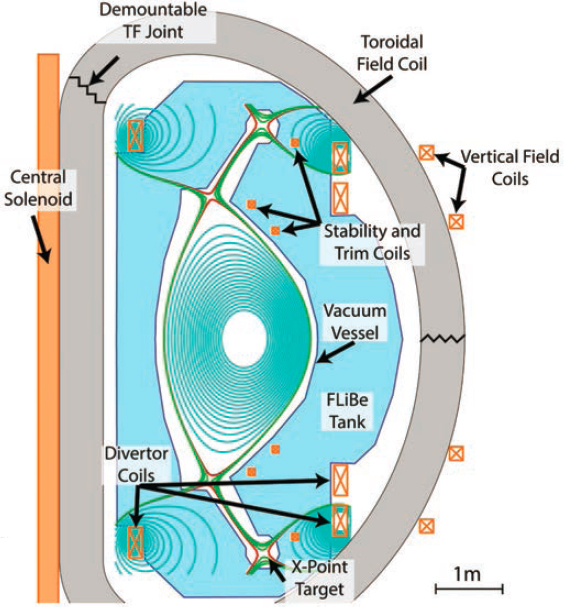
of these issues was presented in the National Academies report on a Strategic Plan for U.S. Burning Plasma Research.7 Some of the key findings are noted here. The essential properties of the plasma-facing “first wall” materials are that their structural properties should remain stable under thermal loads that may exceed 1 MW/m2 and subject to neutron fluxes that lead to displacement events (atoms moved from their natural positions in the material) that can be 50 to 100 times higher than in fission reactors. These materials must be able to survive continuous operation of fusion systems in order to satisfy the requirements of tritium retention, safety, structural integrity, lifetime, and plasma compatibility. Because of these unique operational conditions, the development of plasma simulators that can operate
___________________
7 National Academies of Sciences, Engineering, and Medicine, 2018, Opportunities in Intense Ultrafast Lasers: Reaching for the Brightest Light, The National Academies Press, Washington, DC, https://doi.org/10.17226/24939.
under steady-state conditions that approximate fusion level particle and energy fluxes are critically needed. In the United States, devices such as the PISCES facility at University of California, San Diego, the Tritium Plasma Experiment at Idaho National Laboratory (INL), and the Material Plasma Exposure Experiment being developed at Oak Ridge National Laboratory (ONRL) are providing the testbed infrastructure for evaluating the performance of materials. The development of resilient, next-generation materials for the fusion environment is a critical need regardless of the architecture of the final fusion device. Investing in this materials development before the decision is made on the architecture of the next generation fusion device would be a highly strategic move. Doing so requires close collaborations between plasma physics, nuclear engineering, and materials science research, and should involve more collaborative activities that link the Department of Energy’s Basic Energy Sciences and Fusion Energy Sciences programs. The 2019 National Academies decadal survey on materials science, Frontiers of Materials Research,8 called out “Materials for Extreme Environments,” including for fusion energy systems, as a frontier opportunity for the field.
Achieving Steady-State, High-Performance, Disruption-Free Core Tokamak Plasmas
The development of a plasma that self-organizes its state to not only heat itself, but also sustain its own current and thus confinement, represents a fascinating and fundamental challenge in plasma physics. Previous experiment and theory work have demonstrated that toroidal plasmas self-generate a “‘bootstrap”’ current due to collisional spreading of net currents arising from ion orbit trajectories. Theory suggests that such currents lead to plasma configurations that can reach the very high pressures required for fusion and suppress turbulent fluctuations that would otherwise diffuse fusion heat. However, understanding how to realize this vision rests on a number of foundational physics mechanisms for which fundamental understanding must be developed.
Achieving high performance tokamak plasmas means optimizing the configuration (current, flow, pressure profile) to limit transport losses due to turbulence. This turbulence can be substantially stabilized by plasma flow and through the radial variation in the magnetic field line pitch that is established by the plasma current profile. Variation in flow and magnetic field line pitch can “tear apart” the turbulent eddies and twist them magnetically. Significant progress has been made over the last decade in understanding and exploiting this stabilization process. However, the high pressures and densities in a fusion reactor will lead to
___________________
8 National Academies of Sciences, Engineering, and Medicine, 2019, Frontiers of Materials Research: A Decadal Survey, The National Academies Press, Washington, DC, https://doi.org/10.17226/25244.
the increasing importance of electromagnetic effects in edge turbulence, and our understanding needs to be extended to this regime to project advanced tokamak scenarios to reactor relevant conditions.
Operating at high performance and high plasma pressure also means operating near global instability limits. Instabilities such as NTMs and other magnetohydrodynamic (MHD) modes can arise at high pressure and lead to enhanced transport or plasma termination (disruption). Much has been learned about these global modes, but work remains including studying electromagnetic effects and wave-particle resonances that can modify stability limits and mode behavior. Projection to a reactor rests on understanding these mechanisms and developing quantitative predictive simulation tools.
Understanding global instabilities is important, in particular where that understanding enables one to avoid those instabilities. However, learning to control these instabilities when they do arise is also extremely important. ELMs occur in the steep pressure gradients associated with the H-mode edge in a tokamak. During ELM events, large filaments can form that reconnect as they are ejected, carrying with them a substantial fraction of the plasma energy in the edge region. In current devices ELMs are tolerable. However, in ITER and future reactors, one ELM could lead to significant damage to materials surrounding the plasma. Several techniques have been developed to suppress or minimize the size of ELM events including use of 3D magnetic coils to enhance transport and prevent the pressure from rising to the stability limit (RMP suppression). However, RMP is not effective under all plasma conditions. More work needs to be done to develop full confidence in techniques for controlling ELMs. This will necessitate both theoretical and experimental efforts. The experimental work would be best done in devices with reactor relevant edge conditions (e.g., relevant absolute pressure so that effects like neutral penetration are properly addressed). The theoretical work requires extension of the MHD and turbulence formalisms to new regimes where conventional models break down.
Global instabilities can lead to unplanned plasma termination or “disruption.” Finding ways to avoid or mitigate disruptions is a major challenge for the tokamak concept. Disruptions result in sudden loss of plasma thermal energy to the first wall, which can cause substantial damage to plasma facing components. In addition, there is significant magnetic stored energy associated with the plasma current in a tokamak. Sudden disruption of this current causes very large inductive electric fields that can induce currents in conducting structures around the tokamak and accelerate plasma electrons to very high energies. Induced currents in the tokamak structure (e.g., vacuum vessel) can lead to strong magnetic forces. In existing tokamaks these forces have been strong enough to move the entire tokamak structure vertically. (These are impressive forces. The JET tokamak weighs more than 2,000 tons and disruptions have created forces up to 5 meganewtons. This is equivalent to the peak thrust of the main engines of the space shuttle). The large
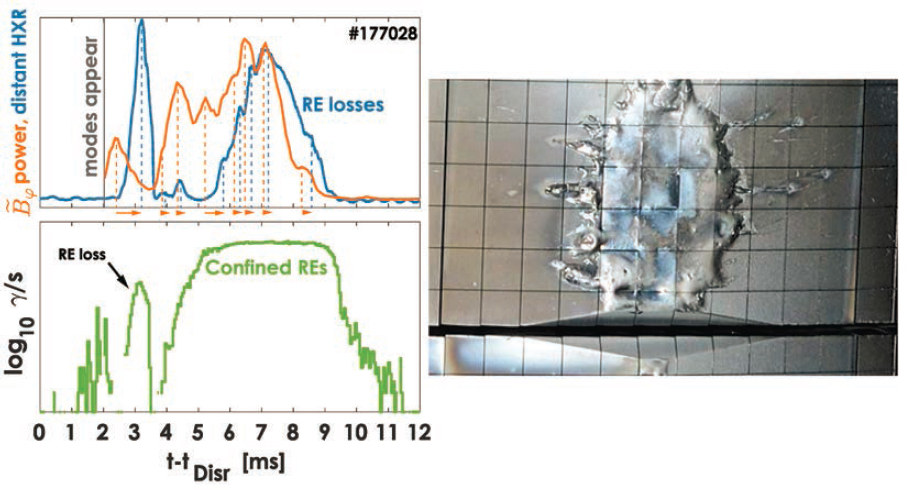
inductive electric fields can also accelerate electrons to very high energies within the tokamak. These electrons, called “runaway electrons,” can reach energies of ’tens of MeV and can carry currents equivalent to the original plasma current (which could be several megaamperes of current). The impact of such an electron beam on material components can cause substantial damage. (See Figure 6.17.) In current experiments, stored energies are in the range of ’tens of megajoules. ITER will have roughly 1 gigajoule of stored energy, split roughly equally between thermal and magnetic energy associated with the plasma current.
The primary strategy to maintain stability and prevent disruptions is to design and sustain an intrinsically stable configuration. This will be achieved by exploiting fundamental understanding of the source of instabilities, combined with real time diagnostics, calculations, or machine learning prediction. If an onset of a disruption can be detected or predicted, preventive measures can, in principle. be rapidly implemented. However, it is always possible that a fault such as a power supply failure or a structure failure that may inject solid material into the plasma leading to large scale distortion, loss of confinement and a rapid disruption. Safe means
of quenching such a fault are needed, which requires solving the triple challenge of high heat (energy) flux, induced device forces (as current rapidly quenches magnetic forces arise) and induced runaway electron beams. Proposed strategies to deal with disruptions include avoidance (staying away from instability) and mitigation (intentional plasma termination ahead of disruption). Both approaches require developing understanding of global instabilities including their nonlinear evolution. Mitigation schemes include the injection of large amounts of neutral gas (massive gas injection) or frozen pellets (single pellets or “shattered” pellet injection) with the goal of controlled plasma termination ahead of an anticipated disruption. The dynamics of runaway electrons are particularly challenging, as they create their own confined plasma, which can undergo dissipative interaction with waves, or become unstable directly.
A key challenge in achieving a steady-state tokamak plasma is to find a way to sustain the plasma current that is needed. In shorter pulse experiments, inductive techniques can be used. A solenoid is threaded through the “hole” in the tokamak and rising currents in this solenoid induces a toroidal electric field inside the tokamak plasma, driving a current. In this arrangement the tokamak is like a transformer with the plasma acting as the secondary. Such inductive drive cannot continue indefinitely as there are limits on how long the current in the solenoid can be steadily increased. ITER will use a solenoid to inductively drive current for 400 s. To achieve a steady state burning plasma, auxiliary means to drive current are needed to operate for longer times in order to maintain the desired, self-stained configuration of current and magnetic fields. Radiofrequency waves can be injected into the plasma to directly drive currents, either by injecting momentum and “pushing” particles in a particular direction or by introducing collisional asymmetries, making it easier to push particles in one particular direction. Promising techniques include electron cyclotron resonance, ultra-high harmonic “‘helicon”’ fast wave (see Figure 6.18) and lower hybrid resonances. These techniques need to be demonstrated with appropriate efficiency in reactor conditions.
Using Three-Dimensional Magnetic Fields to Resolve Major Challenges
For optimal plasma confinement, many critical obstacles can be addressed using magnetic fields that are nonaxisymmetric, that is, without continuous rotational symmetry as is the case in the standard tokamak. As described above in our discussion of the W7-X, stellarators naturally provide stable, steady-state confinement with no disruptions, no runaway electrons, no Greenwald density limit (an operational limit for the density in magnetic confinement devices), and no need for current drive. Since stellarators can confine plasma with negligible internal current, they can be used to confine low-density non-neutral plasmas and pair plasmas (made of electrons and positrons) for basic physics studies, in addition
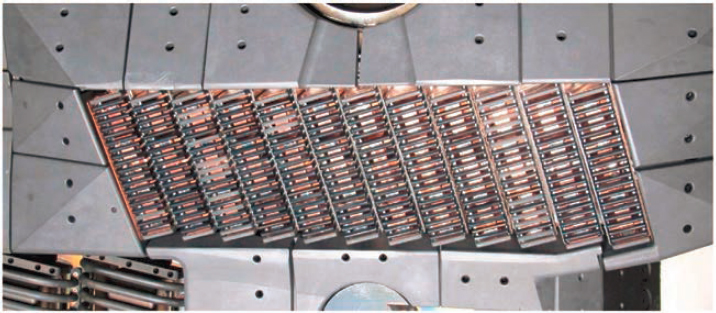
to high-temperature plasmas relevant to fusion. Nonaxisymmetric or “3D” effects are also important in nominally axisymmetric confinement concepts such as the tokamak, which have small unavoidable departures from symmetry. Symmetry in tokamaks is sometimes also intentionally broken by nonaxisymmetric magnetic fields to control edge instabilities. Nonaxisymmetric plasma states can also arise spontaneously in reversed field pinches, and differences between 2D and 3D geometries are significant in other plasma phenomena such as reconnection. However, challenges remain to fully realize the potential of 3D shaping of magnetic fields to optimize plasma confinement. Creating the “perfect magnetic bottle” using 3D magnetic fields is one of the outstanding challenges in plasma physics. The major scientific questions that must be addressed to achieve the perfect magnetic bottle by customizing the 3D magnetic field—also known as 3D shaping—include:
- Optimizing 3D shaping to separately reduce collisional and turbulent transport (see Figure 6.19), improve confinement of fast-particle orbits, and stabilize MHD modes. Can 3D shaping be used to simultaneously optimize all of these processes?
- Is it possible to control turbulence by 3D shaping?
- The confinement of alpha particle orbits in a stellarator fusion reactor—can alpha confinement be optimized 3D shaping?
- What combination of electromagnet topologies, permanent magnets, and diamagnets is best for 3D shaping?
- How can we design stellarators to make the magnets simple, with generous tolerances?
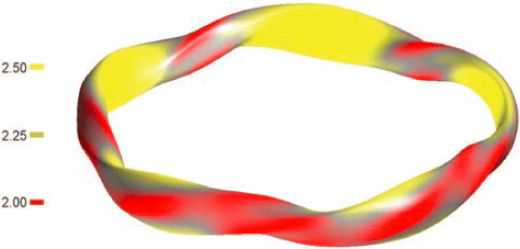
- How can 3D shaping be leveraged to maximize control of the basic properties of the plasma?
- What is the best geometry for a stellarator divertor?
- In tokamaks, what is the mechanism by which ELMs are suppressed or triggered by 3D fields?
- Can ELM control by 3D fields be made reliable and an “every-day” practice?
- How do 3D perturbations in otherwise symmetric magnetic fields affect particle and energy transport?
- How can theory and computations be improved and leveraged to optimize and understand 3D shaping, and investigate configurations that are now beyond current experimental capabilities?
As discussed above, the W7-X stellarator has proven many concepts in using 3D shaping to achieve record confinement and plasma times. The LHD (Large Helical Device), a large stellarator in Japan, achieved several milestones such as a 10 keV ion temperature. The CTH (Compact Toroidal Hybrid) stellarator at Auburn University has collected more evidence that moderate nonaxisymmetric shaping can be applied to a tokamak to eliminate disruptions. Significant theoretical advances were made and new codes have been developed for both collisional and turbulent transport, and have demonstrated that 3D shaping can be optimized to reduce turbulent transport. New algorithms and codes have been developed to design stellarator magnets, and new plasma configurations were demonstrated with exceptional alpha confinement. In tokamaks, 3D magnetic perturbations have been explored, demonstrating that 3D field perturbations can suppress ELMs, modify edge profiles, and control many other properties. Theory and simulation
of 3D effects in tokamaks have advanced significantly, with multiple codes now available that include the plasma response to external perturbations.
In the next 10 years, significant developments in 3D shaping are on the horizon. W7-X is being upgraded with a cooled divertor to enable 30 minute discharges, and a steady-state pellet injector will enable continuous peaked density profiles. The CFQS (Chinese First Quasi-axisymmetric Stellarator) will begin plasma operations early in the decade, providing the first experimental realization of a quasi-axisymmetric field. The EPOS experiment (Electrons and Positrons in an Optimized Stellarator) has been funded to explore pair plasmas. Other stellarator design activities are underway at the University of Wisconsin, Princeton Plasma Physics Laboratory, and the National Institute for Fusion Science (NIFS) in Japan. The Simons Foundation recently began an interdisciplinary project to improve understanding of 3D MHD equilibria and bring state-of-the-art applied mathematics to bear on stellarator optimization. Adjoint analytical methods are now becoming available to obtain the plasma properties (e.g., confinement quality) with respect to variation in plasma or coil shape. These new techniques could transform stellarator optimization.
Related areas of science, technology, and mathematics are making breakthrough contributions that will advance development of 3D plasma confinement schemes. First, high-temperature superconductors enable new options for electromagnetic coils. While it may be difficult to increase the magnetic field strength in stellarators due to the need to support complicated distributions of electromagnetic forces, reducing conductor thickness and cooling demands would still provide additional flexibility in the design. For example, demountable joints in such superconductors would make different coil topologies feasible. Second, advanced additive manufacturing processes will likely enable here-to-fore unachievable 3D configurations. Third, there is enormous expertise in optimizing complex system design available in other fields that can be leveraged for stellarator designs, for example, learning from the design of advanced aircraft.
The United States plays a leading role in some areas of 3D plasma physics and has a more modest standing in others. The use of 3D perturbations for tokamak control was led by the United States, with related efforts now on many tokamaks abroad. Though the stellarator was invented in the United States, the largest such devices today (W7-X and LHD) are located abroad. The United States has made valuable hardware contributions to W7-X, on which scientists from several U.S. institutions collaborate. There are several small stellarators in the United States, all at universities: the Helically Symmetric Experiment (HSX, University of Wisconsin), CTH (Auburn University), and Columbia Non-Neutral Torus (CNT, Columbia University). In the past decade, many significant theoretical and computational advances in 3D plasmas have come from the United States. Having said that, the U.S. investment in stellarator research is small, only ~1.5 percent of the DOE-FES
budget in 2019. With a modest increase in this investment, an opportunity exists to leverage the existing expertise in 3D physics to position the United States as a leader in this area.
Developing Predictive Capability to Enable Design and Control of Fusion Reactors
Experiments have been absolutely essential to progress in MFE research, leading to key discoveries such as the H-mode and edge-localized mode (ELM) suppression using 3D magnetic fields. Experiments are key to developing scientific understanding and validating theory and computation. Moving forward, there will be a greater and more necessary need for theory and computations to lead experiments. The cost of state-of-the-art fusion reactors and the time required to approve, construct and commission systems places a very high premium on having robust, designs from both a physics and engineering perspective. Increasing confidence in the design and construction of new fusion systems will largely come from fundamental theory and computations. Computations that are based on fundamental theories and validated using data from existing systems will be necessary for predictive design that has the confidence of the community. For example, extending the confinement performance from H-mode to the Super H-Mode regime in tokamaks was only possible due to guidance from the EPED model, developed and validated through experimental observation. The design of optimized stellarator experiments was enabled by improved theoretical understanding—the success of W7-X in reducing neoclassical transport was a result of this understanding. As the U.S. MFE program plans for future experimental facilities to lead the international community, there is a need for improved first-principles, validated understanding and predictive capability to help design and then fully exploit these facilities.
Advances in multiscale, multiphysics theory and modeling capabilities across the MFE discipline are necessary to predict not only the plasma physics of 3D configurations, but also the interaction of plasmas and surrounding materials. Perhaps the highest requirement is validating codes on present experiments to build confidence in predictions of fundamentally new physics regimes typical of a fusion power plant. These physics models must ultimately be integrated into the engineering focused codes to develop designs for future fusion experiments, and in particular a fusion pilot plant. There is a hierarchy of approaches spanning whole-plasma modeling (core to first wall), whole-device modeling (adding the divertor, wall and blankets), and whole-facility (including balance of plant and economics to the site boundary). There is also a hierarchy of types of models needed, from first-principles simulations to reduced models that enable more rapid computation for use in scoping/design and potentially real-time control and feedback of experiments.
To meet these computational goals, the MFE program needs to support (ideally collaboratively with other agencies and offices within DOE) experimental and computational studies on fundamental fusion-relevant plasma and material physics. Continued development of validated predictive models with tight coupling to experiments is necessary to the future of the field. To increase collaboration between theory, computation, and experiment, specific programs aimed at this goal are necessary. The DOE-FES and Advanced Scientific Computing Research (ASCR) partnership program Scientific Discovery through Advanced Computing (SciDAC) is one such model that can be expanded, bringing in other partners such as DOE Basic Energy Sciences (BES). These activities would build, refine, and validate predictive models of fusion-relevant plasma and material processes over a range of complexities (first principles to reduced models) and computational cost to meet the need. Validation must be performed with rigorous uncertainty quantification to develop the required confidence in predictive models. Validation should focus on regimes that are relevant to burning plasmas where possible.
Innovations in data analysis and machine learning should be used to complement more conventional model development where appropriate. Investments should be made in computational infrastructure and software engineering to optimally employ current and future high performance computing platforms; and to enable advanced data management and analysis, with the goal of improving the interface between experiments and computation. These advances would be aided by the adoption of data standards and common formats to support benchmarking and accessibility. The MFE program should invest in the processes and infrastructure needed to make the outcomes of large-scale simulations available to the broad community in a way analogous to the distribution of experimental data by major fusion experimental facilities. (For example, MDSplus is a set of data acquisition and software tools widely used by the international fusion community.) Investments should also be made to support software engineers converting legacy production codes to new architectures, and to develop standardized libraries to minimize the overhead of new code development.
It is important to have a balanced approach to investing in both developing computing capability (e.g., producing codes that efficiently use the largest supercomputers) and leveraging computing (e.g., performing computations needed to advance physics and engineering). For example, first principles kinetic plasma simulations are essential to investigate the fundamental physics of fusion plasmas, and its related large computational resource needs are a driver in the plasma community for exascale computing. In the past, funding priorities have driven the community more toward capability computing (use as many processors as possible in the largest machines) rather than providing resources to actually use this capability to evaluate experimental results, design new experiments and drive the science of
MFE forward. Investing in computations enables both continued use of production codes as well as advancing high-fidelity modeling capabilities.
MFE FACILITIES IN THE UNITED STATES
Here the committee briefly discuss the MFE facilities in the United States that have contributed to our understanding of fusion physics and advanced fusion technologies over the past decade. (See Table 6.2.)
DIII-D
DIII-D is currently the largest magnetic fusion research experiment in the United States, located at the DIII-D National Fusion Facility in San Diego and operated by General Atomics for the DOE. (See Figure 6.20.) DIII-D is a multi-institutional user facility whose primary research goals are to:
- Provide solutions to physics and operational issues critical to the success of ITER;
- Develop the physics basis for steady-state tokamak operation as required for efficient power production;
- Contribute to the technical basis for a fusion nuclear science facility, and
- Advance the fundamental understanding and predictive capability of fusion science.
The DIII-D project began in 1986, and its technical capabilities have continually improved, making it a flexible device that can study confinement, stability and divertor physics with a variety of heating and current drive techniques. This capability, in turn, enables development of high-performance, advanced tokamak concepts having simultaneous control plasma profiles both in the core and at the edge of the tokamak. Near-term research on DIII-D addresses plasma configuration scalable to the high gain fusion that is the goal of ITER. Longer-term research focuses on developing techniques to produce stable, high-performance, steady-state (i.e., noninductive) operation in ITER and beyond.
DIII-D has a major radius of R = 1.67 m and a minor radius of a = 0.67 with a nominal aspect ratio of R/a = 2.5. (R is the radius of the entire tokamak torus; a is the radius of the tube of the torus). It can operate with a 2.2 T toroidal magnetic field and 3 MA plasma current, although it generally operates at lower currents, ≤ 2 MA. Eighteen magnetic field-shaping coils operated by a plasma control system provide great flexibility in the shape of the plasma, discharge evolution, and divertor configuration. Divertor cryopumps control the plasma density. DIII-D has 26 MW of external heating capability, split between 20 MW of neutral beam injection (NBI)
TABLE 6.2 MFE Facilities Cited in This Report
| Facility | Description | Facility | Description |
|---|---|---|---|
| Alcator C-MOD* | Tokamak, MIT Plasma Science and Fusion Center. | J-TEXT | Tokamak, Wuhan, China |
| ASDEX-U | Tokamak, Axially Symmetric Divertor Experiment Upgrade, Max Planck IPP, Garching | JT60-U JT60-SA** | Japan Torus 60-Upgrade, Naka Fusion Institute, Ibaraki, Japan |
| CFETR** | China Fusion Engineering Test Reactor, Hefei, China | KSTAR | Korea Superconducting Tokamak Advanced Research, Daejeon, South Korea |
| CFQS*** | Chinese First Quasi-Axisymmetric Stellarator, Southwest Jiaotong University in China. | LHD | Large Helical Device Stellarator, Toki, Gifu, Japan |
| CNT | Columbia Non-Neutral Torus stellarator, Columbia University | LTX-b | Lithium Tokamak Experiment upgrade, Princeton Plasma Physics Lab |
| COMPASS | Compact Assembly Tokamak, Institute of Physics, Czech Republic | MAST* MAST-U** | Mega Ampere Spherical Tokamak, Culham Center for Fusion Energy |
| CTH | Compact Toroidal Hybrid stellarator, Auburn University | MST | Reversed Field Pinch, Madison Symmetric Torus, University of Wisconsin |
| C-2W (Norman) | TAE Technologies Field Reversed Configuration, Foothill Ranch, CA | NSTX* NSTX-U** | National Spherical Torus Experiment and NSTX Upgrade, Princeton Plasma Physics Laboratory. |
| DIII-D | National Fusion Facility Tokamak, General Atomics, San Diego | Pegasus | Pegasus Toroidal Experiment Tokamak, University of Wisconsin |
| EAST | Experimental Advanced Superconducting Tokamak, Hefei, China. | QUEST | Tokamak, Kyushu University, Japan |
| EPOS*** | Electrons and Positrons in an Optimized Stellarator, Max Planck IPP, Garching, Germany | SPARC*** | Commonwealth Fusion Systems tokamak, Cambridge, MA |
| FuZE | Fusion Z-pinch Experiment, University of Washington | ST-40 | Spherical Tokamak, Tokamak Energy, Oxfordshire, UK |
| HBT-EP | Tokamak, Columbia University | SUNIST | Sino-UNIted Spherical Tokamak, Tsinghua University, China |
| Helimakc | Toroidal experiment for studying turbulence, University of Texas | TCV | Tokamak à Configuration Variable (Variable Configuration Tokamak), École Polytechnique Fédérale de Lausanne, Switzerland |
| HIDRA | Hybrid Illinois Device for Research and Application, University of Illinois | TFTR* | Tokamak Fusion Test Reactor, Princeton Plasma Physics Laboratory |
| HL-2A | Tokamak, Chengdu, China | VEST | Versatile Experiment Spherical Torus, Seoul National University, S. Korea |
| HSX | Helically Symmetric Experiment Stellarator, University of Wisconsin | W7-X | Wendelstein 7-X Stellarator, Max Planck IPP, Greifswald, Germany |
| ITER** | International burning plasma experiment, Cadarache, France | WEST | W(Tungsten) Environment in Steady-state Tokamak, Cadarache, France |
| JET | Joint European Torus, Culham Center for Fusion Research, UK. |
* Not now operational or decommissioned.
** Under construction, renovation or upgrade.
*** Design phase.
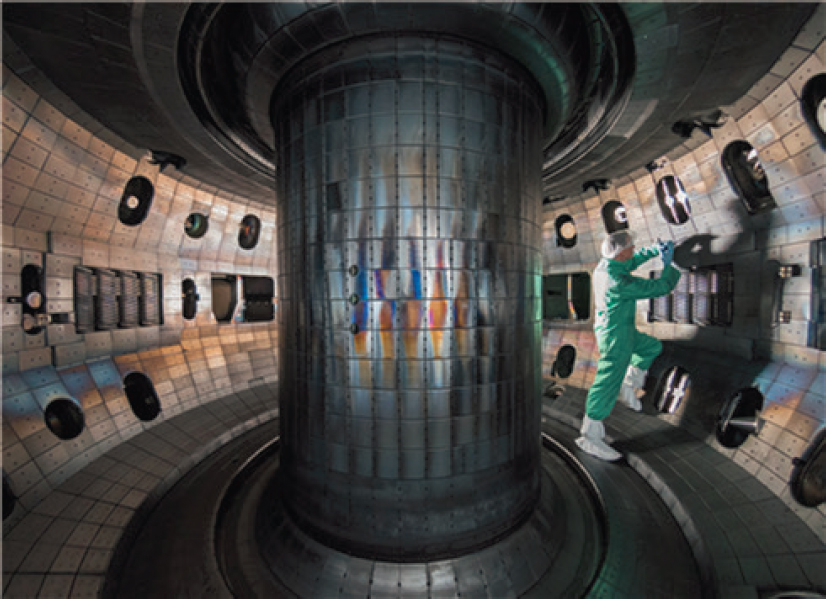
heating and 6 MW of electron cyclotron heating (ECH) and current drive. The neutral beams are configured on- and off-axis, and in the co- and counter-current direction to provide a range of torque and neutral beam driven noninductive current profiles. A key feature of DIII-D is sets of internal and external coils that provide a wide range of 3D magnetic perturbations for edge-localized mode (ELM) suppression and other edge profile control studies. Shattered pellet injection and argon pellet systems are used to mitigate disruption and runaway electrons. (This is a technique by which frozen pellets of gas, either whole or shattered, are injected into the plasma and then evaporate to increase the local gas density.) A lithium and boron “dropper” (a system that dispenses particles smaller than a few hundred microns) is used for wall-conditioning, and a laser blow-off instrument (where a laser pulse ablates a puff of material into the plasma) is available for impurity transport studies. DIII-D has an outstanding, comprehensive set of core, edge, and divertor diagnostics. A close collaboration between theory, computations and experiment enables the data to be readily used to validate first-principles physics simulations for the development of high-confidence predictive tools.
Organizationally, DIII-D is managed by a private company, General Atomics (GA). Multiple national-laboratory and university, as well as GA employees, constitute the scientific staff. Generally, GA employees operate the major systems. Several major subsystems are the responsibility of national laboratory teams while diagnostic systems are the responsibility of university, national laboratory, and GA personnel. Experiments are selected from proposals submitted to Research Opportunities Forum that is open to all and reviewed by a Research Council with experienced team members from GA, laboratories, and universities. Final allocations for experimental time on DIII-D are made by GA management. Experiments are conducted by multi-institutional teams that often include international visitors. The research program is influential. As a measure of impact, consider the papers selected for oral presentations at the most recent IAEA Fusion Energy Conference (the highest visibility conference in the field). Of 42 experimental magnetic fusion papers, 15 utilized DIII-D data, the most of any facility in the world.
NSTX-U
The National Spherical Torus Experiment-Upgrade (NSTX-U) is one of 17 tokamaks worldwide designed to operate in the low aspect ratio regime. (See Figure 6.21.) It is a high-powered, medium-size device that is one of the two largest and most capable low aspect ratio tokamaks in the world, the other being MAST-U in the U.K. The mission of NSTX-U is to:
- Advance the spherical tokamak (ST) as a candidate for a Fusion Nuclear Science Facility (FNSF);
- Develop solutions for the plasma-material interface, including the snowflake divertor and lithium/liquid metal plasma facing components (PFCs);
- Advance toroidal confinement physics predictive capabilities for ITER and beyond; and
- Develop the ST for fusion energy production, for example as an ST Pilot Plant.
Many of ST physics challenges were investigated in NSTX, the predecessor to NSTX-U. NSTX had an aspect ratio of R/a = 0.85/0.68~1.25, operated with plasma currents up to 1.5 MA and with toroidal magnetic fields of up to 0.55 T. NSTX had pulse lengths of up to 1.5 s, and operated with either D+ or He++. NSTX was equipped with a three-source neutral beam capable of injecting 6 MW of power at 90 keV, and up to 6 MW of High Harmonic Fast Wave RF power for heating and current drive. Co-axial Helicity Injection (CHI) was used for noninductive plasma startup. Close-fitting passive conductors, coupled with application of active control
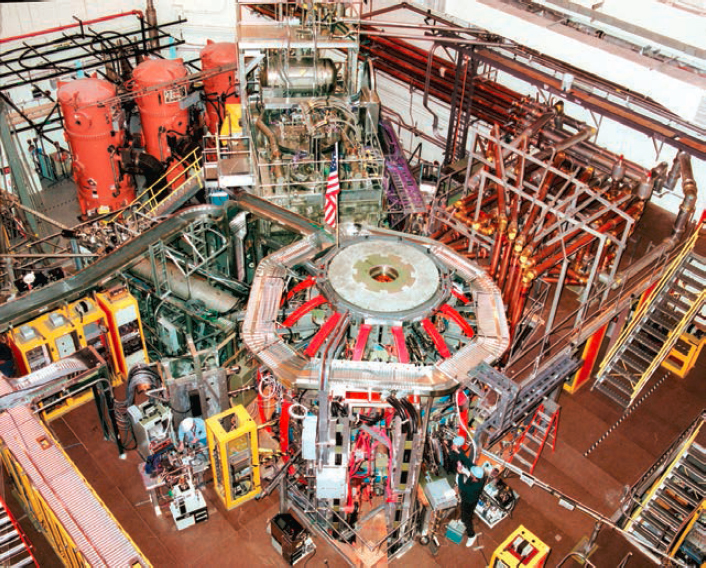
algorithms using applied 3D magnetic fields as actuators, were used to stabilize MHD instabilities and maintain high-performance operations.
NSTX-U will continue to explore physics issues critical to low aspect ratio tokamaks, but with enhanced capabilities. The toroidal magnetic field will be increased from 0.55-1 T, the plasma current from 1.5-2 MA, and the pulse length from 1-5 s. A second, more tangentially injecting neutral beam was added, doubling the total available power up to 12 MW under normal operating conditions. These additions make NSTX-U the most powerful ST in the world, with the highest toroidal field and highest accessible pressure and plasma β. This will enable NSTX-U to achieve up to 10 times higher fusion triple produce (nTτ) and four times higher divertor heat fluxes, reaching levels expected in ITER.
The increased current, field and power will enable NSTX-U to operate at higher temperature and up to five times lower collisionality than in NSTX. Operation at reduced collisionality is critical to resolving how confinement varies with this parameter. If this favorable confinement trend with reduced collisionality is confirmed, that is, exhibiting a stronger trend than observed in tokamaks with conventional aspect ratios, this would be critical information for optimizing designs of compact tokamak reactors having small aspect ratio, high-β.
While there is significant overlap between the two major ST devices—NSTX-U will focus on core physics, and in a complementary fashion MAST-U will focus on boundary physics. MAST-U is equipped with poloidal field coils that will enable more flexible divertor configurations than those that can be produced in NSTX-U. However, NSTX-U can contribute and, in some instances, lead in power exhaust studies. NSTX-U will be using solid lithium coatings to protect PFCs from high heat fluxes, to improve confinement and to suppress ELMs, as was done in NSTX. Solid lithium injectors on the top and bottom of the vessel will double the lithium deposition over that in NSTX. Long-term plans include the development of liquid metal divertors as a possible transformative wall solution.
NSTX-U operated a 10 weeks productive scientific campaign in 2016. However, by the end of that period, it was discovered that one of the poloidal magnetic field coils failed, necessitating NSTX-U to shut down for an extended repair. The NSTX-U Recovery is ongoing, with numerous design improvements, including modification of the vacuum chamber, in order to support flexible operations and increase reliability to achieve key mission goals. New requirements for the divertor heat fluxes have been defined, based on recent models for the SOL heat flux. New error analysis has been conducted, with the goal of optimizing both the global MHD stability and minimizing PFC heat flux asymmetries. New designs of graphite plasma facing components utilize crafted surfaces to reduce the mechanical stresses, allowing tiles to reach temperature of ~1600 C. Improved divertor coil designs simplify fabrication and facilitate turn-to-turn testing. The NSTX-U Recovery project is on track to enhance reliability and safety and provide the highest performance ST device as a robust user facility. NSTX-U is expected to resume operations during 2021.
Alcator C-Mod
Alcator C-Mod is a compact, high-magnetic field, diverted tokamak that was operated at the MIT Plasma Science and Fusion Center (PSFC) from 1993 until 2016. (See Figure 6.22.) C-Mod has a 0.68 m major radius and 0.22 m minor radius and can operate with up to 8 T magnetic field using liquid nitrogen cooled copper magnets. The high magnetic field enables the small device to create the dense, hot plasmas (> 100 million degrees) of the type expected in a fusion reactor. C-Mod holds the record for the highest volume average plasma pressure in a magnetic confinement device, which is an important metric for fusion performance. The plasma is heated to very high power densities using radio-frequency heating from novel antennae and sustained with microwave current drive. The third in a series of high-magnetic field tokamaks at MIT, C-Mod leveraged PSFC expertise in high-field magnets, high power radio-waves, plasma physics, fusion materials,
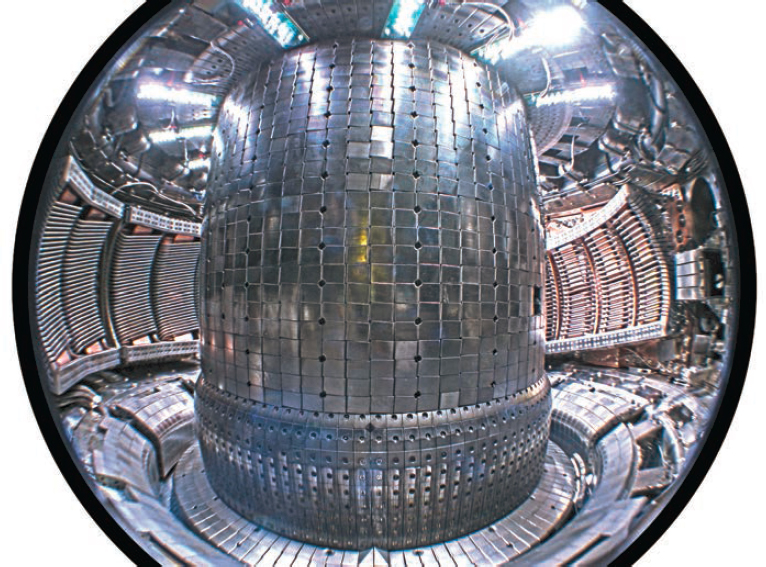
theory and simulation, and cutting-edge engineering. This experimental device enabled a wealth of new and important results.
C-Mod has contributed data extending physics understanding into new parameter spaces to develop new tokamak operating regimes while demonstrating important technical solutions to fusion problems. The relatively large power in a small device allows for tests of heat exhaust at reactor-relevant heat and particle fluxes in reactor-relevant divertor geometries. To handle these conditions, C-Mod pioneered the use of the vertical target-plate divertor with refractory metals, a design that has been incorporated into other devices including ITER. Studies on C-Mod have clarified the roles of rotation and shear on transport and stability across the plasma and have demonstrated stable operating regimes at high magnetic field that may eliminate explosive instabilities.
Until 2016, C-Mod was one of three domestic tokamaks and a DOE user-facility. C-Mod engaged collaborators from all over the world to plan and execute experiments. The team of over 100 professors, scientists, students, engineers, and technicians made C-Mod the largest experiment at MIT with participation from many MIT academic departments. Following completion of operations, the facility was placed into safe shutdown, with no additional experiments planned at this
time. There is a wealth of data archived from the more than 20 years of operations, and the experimental and theoretical teams continue to analyze the results and publish them in the scientific literature.
Smaller MFE Research Facilities in the United States
Pegasus is an ultra-low aspect ratio tokamak at the University of Wisconsin that operates with a major radius of R ~0.35 m, R/a ~1.13-1.3 and a toroidal magnetic field strength of 0.17 T. Its mission is to explore very high-β confinement and stability, and to develop noninductive discharge start-up techniques. Pegasus has achieved H-mode plasmas, with threshold powers for accessing the H-mode well above (~15×) that predicted for the Pegasus operating parameters with plasma currents up to 100 kA.
Lithium Tokamak Experiment upgrade (LTX-b) is also a low aspect ratio tokamak at Princeton Plasma Physics Laboratory having R = 40 cm, R/a ~1.55, a toroidal magnetic field of 0.17 T and plasma currents up to 100 kA. The purpose of LTX-b is to develop use of liquid lithium walls to protect plasma facing surfaces, and to study their effect on plasma performance. Its predecessor LTX, used lithium coatings on a high-atomic weight wall, and it exhibited flat electron temperature profiles and enhanced confinement without having the lithium dilute the core plasma or radiate power. LTX-b will extend the capabilities of LTX with 700 kW of NIB heating and fueling, 100 kW of ECH/EBW (electron Bernstein wave) coupling for electron heating, higher magnetic field and current, longer pulse length, and upgraded diagnostics.
The Madison Symmetric Torus (MST) at the University of Wisconsin is a reversed-field pinch (RFP) physics experiment, which unlike a tokamak is magnetized and heated almost entirely by plasma current, achieving a temperature up to 2.5 keV. In the RFP, the toroidal magnetic field is weaker than the poloidal magnetic field, and it actually reverses direction in the plasma near the edge. The mission of MST, part of the Wisconsin Plasma Physics Laboratory user facility, is to study fusion and astrophysical implications of reconnection, turbulence and dynamo formation. A 1 MW NBI is used to enable studies of fast particles and their role in the reconnection process. MST also operates as a low field tokamak to study specific tokamak-related issues. A wide range of diagnostics is available for characterizing the plasma.
HSX, the Helically Symmetric Experiment Stellarator, also at the University of Wisconsin, is a quasi-helically symmetric (QHS) stellarator with R = 1.2 m, a = 0.15 m and toroidal magnetic field up to 1.25 T. It has up to 200 kW of electron cyclotron heating, which can energize the electrons up to 2-2.5 keV in the core. By the nature of its QHS design, neoclassical electron thermal transport was reduced. HSX has demonstrated conditions important for reducing turbulence-driven
transport, maintaining plasma stability, and for good particle confinement of trapped high-energy electrons. HSX also serves as a flexible divertor test platform, able to produce either an island or nonresonant divertor.
HIDRA (Hybrid Illinois Device for Research and Applications) at the University of Illinois is a classical stellarator with R = 0.72 m and a = 0.19 m, with magnetic fields up to 0.5 T. The main focus of HIDRA is to study plasma-material interactions, including liquid lithium science and technology. The Compact Toroidal Hybrid (CTH) device at Auburn University is designed to study how MHD stability in a stellarator depends on 3D shaping of the plasma. It has R = 0.75 m, a = 0.29 m, magnetic field of 0.7 T, and it has independently controlled magnet coils that can produce a wide variety of configurations, enabling conditions appropriate to investigating disruptions.
The mission of the HBT-EP device at Columbia University is to utilize an adjustable close-fitting conducting wall for passive stabilization and applied external magnetic perturbations for active control of MHD modes. It has R = 0.92 m, a = 0.15 m and toroidal magnetic field of 0.35 T. The Helimac at the University of Texas at Austin (R = 1 m, 0.1 T) is a toroidal device that is used to study plasma turbulence at high collisionality. With magnetic field lines having a low pitch, its configuration approximates that of an infinite cylinder. Flow shear is externally applied and can be controlled. The plasma is colder, with Te ~10 eV and number densities of 1011 cm−3.
THE U.S. MFE EFFORT AND ITS INTERNATIONAL CONTEXT
U.S. Leadership in the International Fusion Research Effort
Historically, the United States has been at the forefront of the MFE international research community in virtually all major areas. In large part, this is due to major investments made during 1980-2000, developing a diverse set of research facilities (TFTR, DIII-D, NSTX, Alcator C-Mod), coupled to a strong base program of experiment and theory. A measure of U.S. scientific leadership is reflected in the recipients of significant international research prizes, such as the Nuclear Fusion Award and the Alfvén Prize. U.S. scientists constitute a disproportionately large number of winners. Eight out of twelve Nuclear Fusion Awards to-date have recognized work led by U.S. scientists from across the U.S. fusion program. The Alfvén Prize of the European Physical Society was established in 2000, and U.S. scientists have been recipients in 8 of the 19 years. Although the prize is for all areas of plasma physics, the U.S. winners have been mostly from the fusion research community.
This recognition of the excellence of U.S. research acknowledges past accomplishments, and is unlikely to continue into the future unless current trends
are reversed. Simply stated, U.S. leadership is lagging. The United States is poised to lose research leadership of the world’s MFE programs for two coupled reasons. First, there is, and has been for several decades, a lack of major investment in new U.S. facilities and experimental capabilities. Second, there is currently an absence of a U.S. strategic plan for fusion energy. This latter issue is being addressed at the time of this writing by the ongoing CPP (community planning process) for the DOE Fusion Energy Sciences. The committee is hopeful that the resulting plan will be well received, implementable and regularly updated.
While the United States had made significant investment in the international ITER experiment, the lack of major investment in domestic experimental capabilities is startling when compared to investments being made internationally. With a twenty year gap in major investment in new domestic facilities, along with the closure of TFTR and Alcator C-Mod, the United States is left with only two major medium-scale facilities—DIII-D (started in 1986) and NSTX-U (NSTX started in 1999 and was upgraded to NSTX-U in 2012). The contrast internationally is striking, with major investments by our partner nations in new facilities in the European Union (the WEST tokamak and the W7-X stellarator started in 2016), Japan (the JT-60SA tokamak will begin operations in 2021), China (the EAST tokamak started in 2006), and S. Korea (the KSTAR tokamak started in 2008). Substantial upgrades have occurred or are planned for the JET tokamak (UK), the ASDEX-U tokamak (Germany), and the LHD stellarator (Japan). The 2012 Fusion Energy Scientific Advisory Committee (FESAC) report Opportunities and Modes of International Collaboration During the ITER Era states that “the capabilities of new experimental facilities (most with superconducting coils and very long pulse capabilities) in the EU, China, Japan, and Korea would soon rival and in several important areas exceed those of major U.S. fusion facilities.”
U.S. Participation in International Facilities
U.S. fusion research strategy has an increasing focus on participation in newer international long-pulse experiments with superconducting magnets including EAST (China), KSTAR (S. Korea), and W7-X (Germany). EAST began operation in 2006 and KSTAR began in 2009. Non-U.S. proposals for new facilities include the superconducting Divertor Tokamak Test facility that would be built by the Italian National Agency for New Technologies, Energy, and Sustainable Economic Development’s fusion laboratory in Frascati, Italy, and the China Fusion Engineering Test Reactor (CFETR) is under consideration as a new fusion facility to demonstrate self-sufficient tritium breeding. While researchers in the U.S. fusion community welcome these international opportunities, it is not clear how international cooperation by itself will enable U.S. fusion researchers to maintain a world leadership position without new facility starts in the United States.
The United States has made and continues to make important contributions to the world’s largest currently operating fusion device, the Joint European Tours (JET). This includes involvement in testing important auxiliary systems relevant to ITER (e.g., the ITER-like Shattered Pellet Injector), plasma diagnostics, and experimental operating scenarios (e.g., deuterium-tritium scenarios). Additionally, simulation codes (e.g., TRANSP) developed by U.S. scientists have been adopted by international partners and are now routinely used for scenario modeling in the JET program and across EUROfusion ITER-related activities.
For intermediate-size tokamaks (ASDEX Upgrade, Germany; TCV, Switzerland; MAST Upgrade, UK), many bilateral collaborations exist between the U.S. and EU partners. Prominent recent examples of U.S. contributions include temporarily moving diagnostic devices from U.S. facilities to EU machines, and joint experiments on multiple machines to develop understanding and robust demonstration of control schemes and new plasma scenarios.
A U.S. contribution to fusion research in the EU is participation in the W7-X stellarator project. This includes the construction and operation of five large auxiliary coils and an X-ray spectrometer, as well as the development of fluctuation diagnostics and a pellet injector. This work is carried out at three U.S. national laboratories (Princeton Plasma Physics Laboratory, Oak Ridge National Laboratory, and Los Alamos National Laboratory) and three U.S. universities (Auburn University, University of Wisconsin, Madison, and Massachusetts Institute of Technology), supporting W7-X with equipment that has been funded, designed, and produced in the United States and with related magnetic field and plasma diagnosis and modeling.
The United States is playing a significant role in developing new fusion programs in Asia. Major contributions have been made to new Asian devices, notably in EAST (China), KSTAR (S. Korea), HL-2A (China), and J-TEXT (Japan). A strong relationship continues with smaller spherical tokamaks (QUEST at Kyushu University, Japan; VEST at Seoul National University, S. Korea; SUNIST at Tsinghua University, China). A major focus of an international partnership on QUEST has been in the use of long-pulse superconducting devices to develop steady-state plasma scenarios. Collaborations on EAST have made advances in plasma control and wall conditioning techniques developed collaboratively with and initially demonstrated on DIII-D. Novel computer science hardware and software infrastructure has improved data movement, visualization, and communication and enabled scientists in the United States to remotely conduct experiments using the EAST facility. In July 2017, Chinese researchers using EAST achieved a stable 101 second steady-state high confinement plasma, setting a world record in long-pulse H-mode operation. Similarly, physicists at Princeton Plasma Physics Laboratory have connected remotely to run experiments on KSTAR. U.S.-Asia cooperation aided development of HL-2M under construction in China and in the physics
design of the CFETR burning plasma facility under consideration in China, where the United States provides design expertise and simulation codes.
MFE AND THE PRIVATE SECTOR
Since the Plasma 2010 report, the fusion energy landscape has changed significantly with the rapid growth of privately funded fusion companies. The recently formed Fusion Industry Association includes 21 member companies who are working toward commercial fusion energy within the United States and abroad. Around $1 billion of private capital has been invested in these 21 companies over the last 10 years. Prominent examples include:
- TAE Technologies (Foothill Ranch, CA) has raised the largest amount of venture capital of any privately funded fusion company to date. (See Figure 6.23.) TAE fusion efforts have focused on a beam-driven field-reversed configuration (FRC) concept. TAE has built a series of devices and is currently operating the C-2W device, 30 m long with a diameter of 0.8 m in the confinement region. Up to 21 MW of neutral beam power is available and has been used to produce FRCs lasting 30 ms with total temperature up to 2 keV (maximum electron temperature of 400 eV). The company has expressed interest in utilizing fusion fuel that does not produce neutrons, in particular the p-B11 reaction.
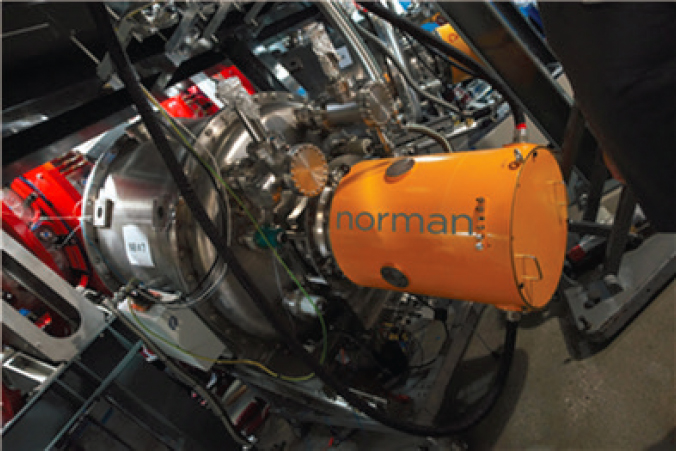
- Commonwealth Fusion Systems (Cambridge, MA), one of the newest fusion companies focused on innovating the tokamak concept using high-temperature superconducting magnets capable of providing very high magnetic field. CFS has attracted major funding from the Italian energy company ENI and subsequent investment from Breakthrough Energy. Near term focus for the company is the development of tokamak magnets based on rare-earth barium copper oxide (REBCO). A first test of these magnets for CFS would be the SPARC tokamak, which the company plans to use D-T to reach the burning plasma regime. CFS is targeting construction and operation of SPARC in the 2020s.
- General Fusion (Burnaby, British Columbia, Canada) has raised substantial capital to develop a fusion reactor based on a magneto-inertial concept. General Fusion’s concept is based on utilizing shock waves driven in liquid metal to compress a magnetized plasma target to fusion conditions.
- Tokamak Energy (Oxfordshire, UK) is focused on the Spherical Tokamak concept as a route to commercial fusion energy. Tokamak Energy is planning to utilize high temperature superconductors to enable high-field, compact spherical tokamak fusion reactors. The company is currently operating the ST40 device which uses a 3T magnetic field and has a major radius of 0.4 m.
Government investment has both indirectly and directly enabled the growing private fusion industry. The indirect support stems from decades of investment in the federally funded fusion research effort, which has built a knowledge base that underlies all the current privately funded fusion ventures. Direct support for the fusion industry is a recent phenomenon and includes investment in a fusion energy program by the ARPA-E agency within DOE as well as new programs within DOE Fusion Energy Sciences. ARPA-E had a 3-year program focused on fusion energy called ALPHA that was announced in 2015. The program was focused on “intermediate density” routes to fusion energy; concepts that fell between lower density MFE approaches and high-density inertial confinement fusion. This program primarily involved researchers interested in magnetized target fusion, an approach that blends MFE and inertial confinement fusion (ICF) approaches. ALPHA program participants included several fusion companies as well as university-based efforts that eventually lead to the formation of new fusion companies, in part due to ARPA-E support. ARPA-E has recently announced a second program in fusion energy research, the BETHE program, which targets lower-cost fusion energy concepts and innovative research that can help lower the cost of mainline fusion devices, including tokamaks and stellarators. DOE Fusion Energy Sciences recently created the INFUSE program as a route to public-private partnership in fusion energy research. INFUSE is modeled after the DOE Office of Nuclear Energy GAIN program and gives companies working on fusion energy access to resources at DOE national laboratories (funds go to the laboratories to support work for the fusion company).
A limitation in the current INFUSE program is that it does not allow fusion companies to work with university researchers in the MFE area. There are public-private programs that go beyond the INFUSE model that could be utilized by DOE-FES. In particular, NASA’s Consumer Orbital Transportation Services (COTS) program was successful in stimulating the development of private solutions to reaching near-Earth orbit. A COTS-like program could also work in the fusion energy space, using milestone reimbursement to incentivize private companies to perform innovative research and development relevant to commercializing fusion energy.
In addition to industry focused on developing fusion reactors, the U.S. MFE program engages other industry partners, in particular as part of the ITER project. As of June 2019, $616 million in contracts has been awarded to U.S. industry to develop components for the ITER project. These components have ranged from superconducting magnet components, to cooling water systems to steady state electrical network components.
THE MFE WORKFORCE
The workforce for the U.S. MFE research program has been evaluated recently through two processes: (1) a 2014 DOE FESAC subcommittee on MFE Workforce development, and (2) a survey conducted by the University Fusion Association (UFA) that produced a white paper on the “Status of university-based fusion science research” in 2017. Both of these evaluations expressed concerns over the status of university research groups in the MFE area. Survey data indicated an aging faculty and uncertainty on the prospect for future faculty hiring in MFE areas. The reports, and in particular the UFA report, raised concerns over declining University participation in DOE-FES research programs. Over the last decade, there has been a major shift in the types of FES programs that engage University researchers. A major university experimental facility, Alcator C-Mod, ceased operations during this period (first slated for shutdown in 2012 but continued operating until 2016). In addition, a program that had supported a number of on-campus experimental facilities, the “Innovative Confinement Concepts” (ICC) program, was discontinued. At the time of these transitions, there were limited funding opportunities, and more importantly, access to intellectual leadership opportunities, for affected university researchers to reengage with FES-funded MFE research. While funding is certainly important to maintaining healthy university programs, it is intellectual leadership that is often the most important currency in driving decisions for faculty hiring. University administrators and department faculty want to see that new hires have the opportunity to work on the most important research that has the most impact in the field in question and that there is a path to grow into national and international leadership. If it is perceived that such opportunities are not available, it is likely that hiring decisions will favor other fields of science or engineering.
The demise of visible on-campus programs and the lack of equivalent opportunities for university researchers contributed directly to the uncertainty in future hiring prospects in MFE.
FES has recently implemented regular funding opportunities for research using the DIII-D tokamak, NSTX-U, and international experiments at facilities including W7-X, MAST-U, KSTAR, and EAST. These programs are very welcome and have provided new opportunities to engage university researchers in the program. However, they do represent a shift to a new paradigm of off-campus research and a potentially more difficult path to intellectual leadership in the field. For major user facilities in other areas of science (and plasma science), such as light sources operated by DOE BES and laser facilities utilized in HEDP research, the user is the clear intellectual leader in the science being performed. The operator of the facility is focused on, for example, providing photons and the high-impact science is tied to the target or sample that the user designs. This clear separation of roles is not present in MFE national facilities. The facility is designed with a particular goal or set of goals in mind and the team operating it is focused on achieving these scientific goals; as such the scientific leadership is generally controlled by that team. For current and past U.S. MFE facilities, the leadership team is a single institution (in contrast with major facilities and missions in other fields, such as major space missions where the team generally has PIs from multiple institutions). This structure does not make it easy for university faculty to see a path to intellectual leadership and to engage in the research program. Credit is due, however, to the institutions that currently operate U.S. MFE national facilities who have attempted to work within the current structure and engage collaborators/users in the scientific leadership. For example, while ultimate authority in setting scientific focus and runtime allocation for the DIII-D tokamak rests with General Atomics (working with DOE-FES), the DIII-D program engages collaborators, including university researchers, in leading scientific thrusts and in deciding which proposals get runtime. This structure has led to university researchers growing into intellectual leadership roles and leading visible research programs on DIII-D. This is also true on international facilities, in particular the W7-X stellarator which has adopted a “one team” approach that engages collaborators in W7-X program leadership. U.S. researchers have been able to grow visible programs with leadership on W-7X for this reason, including recently hired faculty at U.S. universities. While it is difficult to change leadership structures of existing facilities, adopting policies like the “one team” approach, coupled with appropriate funding opportunities, could stimulate more engagement of universities in existing MFE programs. New major facilities should consider broader engagement from all stakeholders in the program and might be developed with teams drawn from multiple institutions including labs, universities and industry. The science of MFE can be addressed at facilities at a range of scales; there have been very few opportunities over the last decade for new intermediate scale and small-scale facilities. There are
a range of frontier scientific opportunities that could be addressed at both scales. For example, quasi-symmetric stellarator at intermediate scale and a range of MFE technology and engineering issues could be addressed at small-scale. Opportunities to site these kinds of facilities at universities would offer a clear path to scientific leadership and enhanced visibility of MFE research.
These demographic changes and shifts in the types of funding opportunities for universities come at the same time as strong growth in privately funded fusion ventures and also a recent growth in federal funding for fusion research from DOE-FES and DOE ARPA-E. There is strong demand for research scientists in the MFE area and in particular a need for a workforce skilled in fusion engineering issues including materials and nuclear technology such as tritium breeding. University programs are a critical source of skilled researchers for the MFE workforce and these programs must be renewed and strengthened to meet these needs.
FINDINGS AND RECOMMENDATIONS
U.S. magnetic fusion energy (MFE) research has long defined the forefront of fusion energy research for the international community.
Finding: While the United States is still a major contributor to international MFE efforts and benefits from these collaborations, the U.S. program has lost ground and is at risk of losing leadership in several areas of MFE research.
Funding for MFE through DOE-FES has seen unprecedented growth over the last few years, driven in part by growth in funding for ITER in response to significant progress in and new management of the project. Private investment in fusion energy research has grown substantially and helped boost federal programs through the development of private-public partnerships. At the same time, DOE leadership and Congress have made it clear to the community that continued strong support for the MFE program is contingent on the development of a community-driven, consensus strategic plan for MFE.
Finding: The absence of a consensus strategic plan for fusion research in the United States is an important factor in our falling behind on international developments, a situation compounded by the lack of vetted designs for new experimental facilities.
Such a strategic plan for the fusion program will allow DOE and Congress to make informed decisions about the specifics of fusion program funding, will position the community to respond to new opportunities (for example, new major facilities) and be able to prioritize in the event of downward funding pressure.
The NAS Burning Plasma report called for regular strategic planning in the U.S. MFE community and called out the need for new experimental facilities, in particular at large scale. At the time of this writing, an FES community planning process is being conducted with the goal of developing a strategic plan. There also are opportunities for U.S. leadership to be reestablished through investment in smaller intermediate scale facilities.
Finding: A roadmap is needed that is enabled by new experimental MFE facilities in the United States with opportunities across a range of scales when appropriate.
Finding: To enable proper planning and to enable creation of a roadmap, ongoing feasibility and facility design activities are essential.
Recommendation: DOE-FES should undertake regular strategic planning, led by the U.S. magnetic confinement fusion energy community, as recommended in A Strategic Plan for U.S. Burning Plasma Research (National Academies of Sciences, Engineering, and Medicine, 2019).
Recommendation: Aligning with A Strategic Plan for U.S. Burning Plasma Research (National Academies of Sciences, Engineering, and Medicine, 2019), DOE-FES should develop a roadmap for the development of commercial fusion power in the United States.
Over the last decade, the landscape of MFE research at universities has changed substantially. Programs that had funded large university experimental efforts were terminated and new equivalent opportunities to participate in forefront MFE research were not made available to universities. At the same time, the average age of university faculty and researchers is increasing and new hiring in MFE areas has declined. At some institutions this is reaching a critical point where longstanding MFE programs may cease to exist.
Finding: Declining participation by universities in the MFE program reduces the level of innovation in the program and is a direct threat to the health of the field. It is essential that the MFE program respond to this crisis.
Finding: Renewing and growing new efforts at universities could be enabled by providing university researchers opportunities to participate in and, more importantly, lead the most important research programs in the field.
This opportunity for intellectual leadership is essential to convince university faculty and administrators that hiring in MFE should be prioritized over hiring
in other areas of research in science and engineering departments. Creating such opportunities represents an important but indirect way to promote faculty hiring. Other fields of plasma science have used more direct approaches to reinvigorate their fields, for example the NSF Faculty Development Program in Space Sciences provides, along with other resources, funding to pay the salary of a newly hired faculty member until tenure is granted. This has been and continues to be effective in creating new faculty positions at several institutions. The program signals the importance of this area of work to the funding agencies and lowers the cost to the university of bringing in a new faculty member.
Finding: There is a need to grow efforts in fusion engineering and an opportunity exists to stimulate university programs in this area using both the indirect and direct mechanisms discussed above.
Recommendation: DOE-FES should structure funding opportunities in magnetic confinement fusion energy to provide leadership opportunities to university researchers and to directly stimulate the hiring of university faculty.
Examples of the above include major new facilities or missions that could be organized with leadership teams that involve university researchers; major activities in the field could be organized around centers that are led by teams including university researchers; and specific programs could be implemented to provide funds or other incentives for the creation of faculty positions (example: NSF Faculty Development Program in Space Sciences).
Finding: A recent Office of Management and Budget decision targeted at limiting duplication in education and outreach programs in funding agencies caused the loss of discipline specific graduate fellowships and outreach programs in DOE Office of Science (SC).
In DOE-FES, this resulted in the loss of the Fusion Energy Sciences Graduate Fellowship Program and the National Undergraduate Fellowship (NUF) Program in Fusion. Working within the new rules, SC has attempted to replace these programs. A new Internship program for graduate students has been established that provides short-term funding (< 1 year) for students to spend time at national laboratories working on their thesis project. The NUF program has been merged with the DOE Science Undergraduate Laboratory Internships (SULI) program that provides research opportunities for undergraduates at national laboratories, but the possibility of working on MFE research at universities was eliminated.
Finding: These programs are important but lack the effectiveness of the former graduate fellowship and NUF program in attracting new talent into the MFE field.
The lab internship program is useful for students who have already made the decision to work in MFE but is not as effective as a 3-year graduate fellowship in attracting students to the field.
Finding: The NUF program and the graduate fellowship could be used as a tool to enhance diversity within the MFE research community.
It should further be noted that the removal of student support for university based MFE research further disincentives universities from hiring or retaining faculty engaged in MFE science.
Recommendation: The DOE Office of Science should restore discipline-specific graduate fellowships and undergraduate research programs that support magnetic confinement fusion energy (MFE) research at U.S. universities as a vehicle for attracting new and diverse talent into mission-specific areas such as MFE, and for maintaining a presence in university science and engineering programs.
Finding: There has been significant growth in nontraditional support of MFE research—that is, support other than that provided by DOE-FES, including privately funded fusion companies, philanthropic organizations, and DOE-ARPA-E.
Most of these efforts are based on nonmainline approaches to magnetic fusion, significantly broadening the range of risk-reward tradeoff with a goal to develop lower cost paths for fusion. The emergence of these efforts has occurred while the DOE-FES program has become more concentrated on mainline approaches and ITER. The breadth of the collective MFE portfolio is therefore similar to that when DOE-FES funded a wider range of approaches, like the Innovative Confinement Concepts program. However, the structure is complicated in having private investments and federal support in different offices.
Finding: There is a danger that the knowledge base, including that generated by former DOE-FES-supported research, could become increasingly fragmented. Some challenges, for example the development of key technologies and materials, are similar even if the fusion configurations are distinct. Solving these challenges through separate efforts increases overall cost and timescales.
Recommendation: Federal agencies funding the development of magnetic confinement fusion energy science and technology (DOE-FES and DOEARPA-E) should leverage privately and philanthropically supported fusion research and vice versa.
Collaborative programs that bridge the public-private sectors can advance fusion development more effectively if they are adequately coordinated. The new INFUSE program is a step in this direction, however the opportunity to be involved should not be limited to DOE national labs. Many of the privately funded efforts and those being proposed by ARPA-E are closely related to projects that were formerly supported at universities. There are also private entities whose business models are focused on supporting capabilities like computation or technology and not the development of a fusion power source per se. In particular, DOE-FES can facilitate a coordinated effort of the combined public-private sectors through leveraged investments that support high-risk, high-reward elements of a balanced portfolio of different approaches and by supporting facilities and capabilities for the development of technologies, materials and computing capabilities that are largely generic to fusion systems.


























































